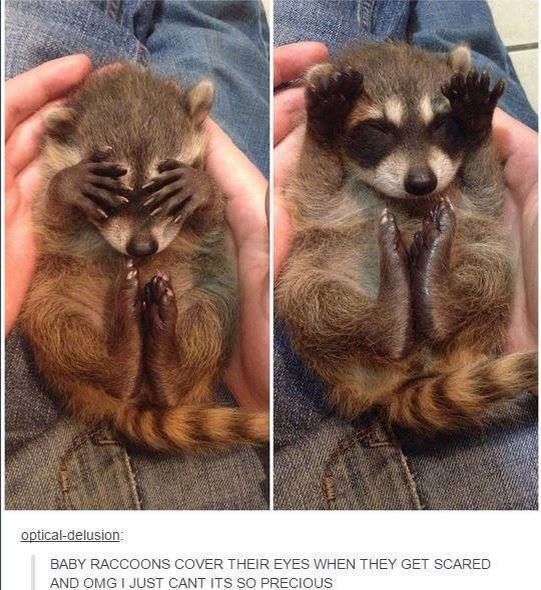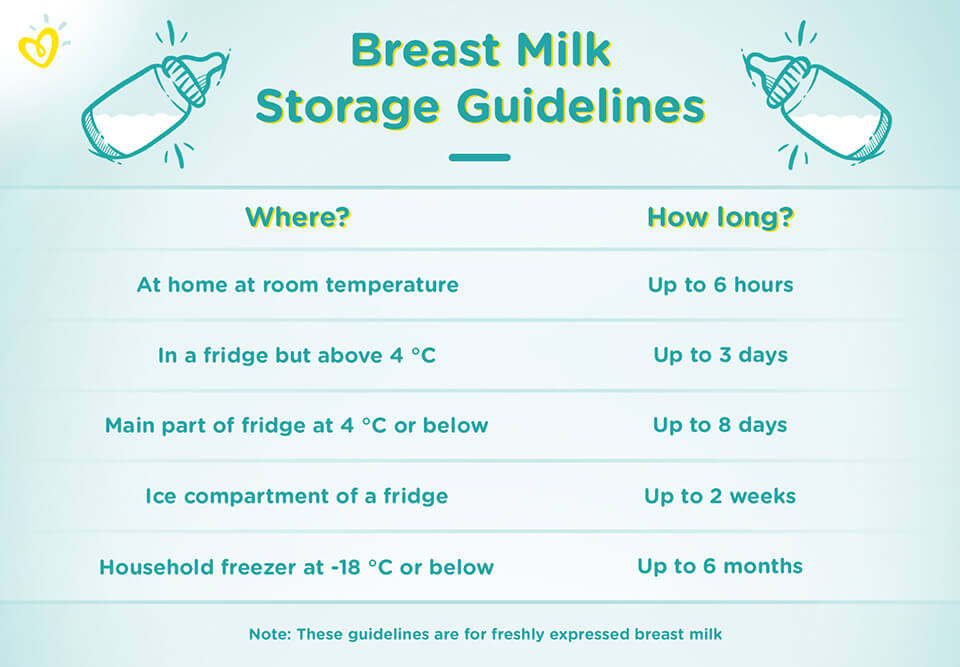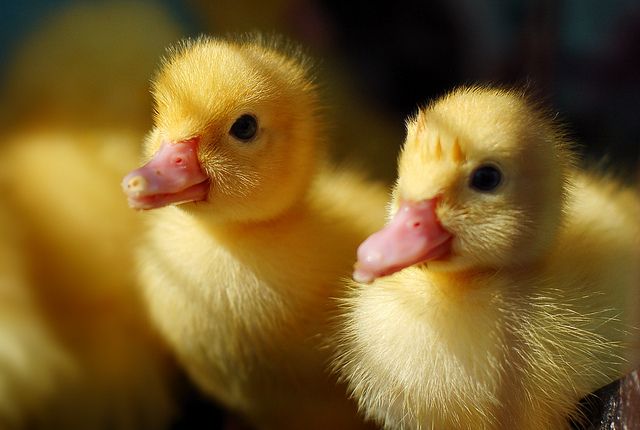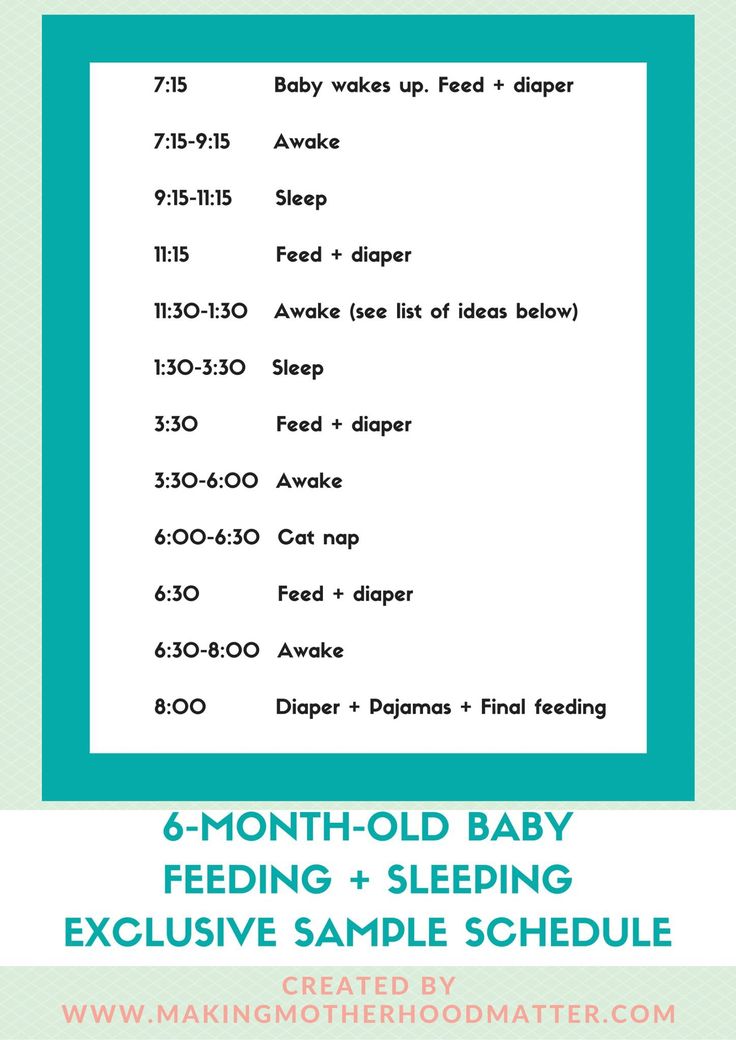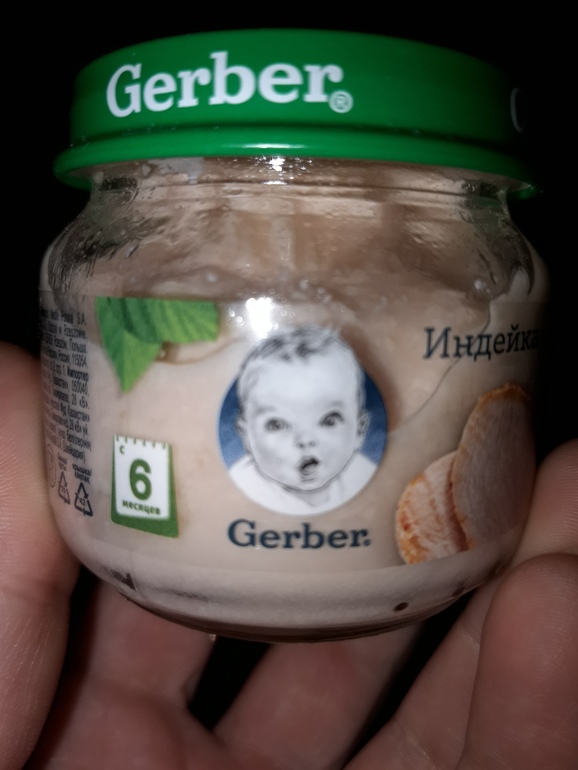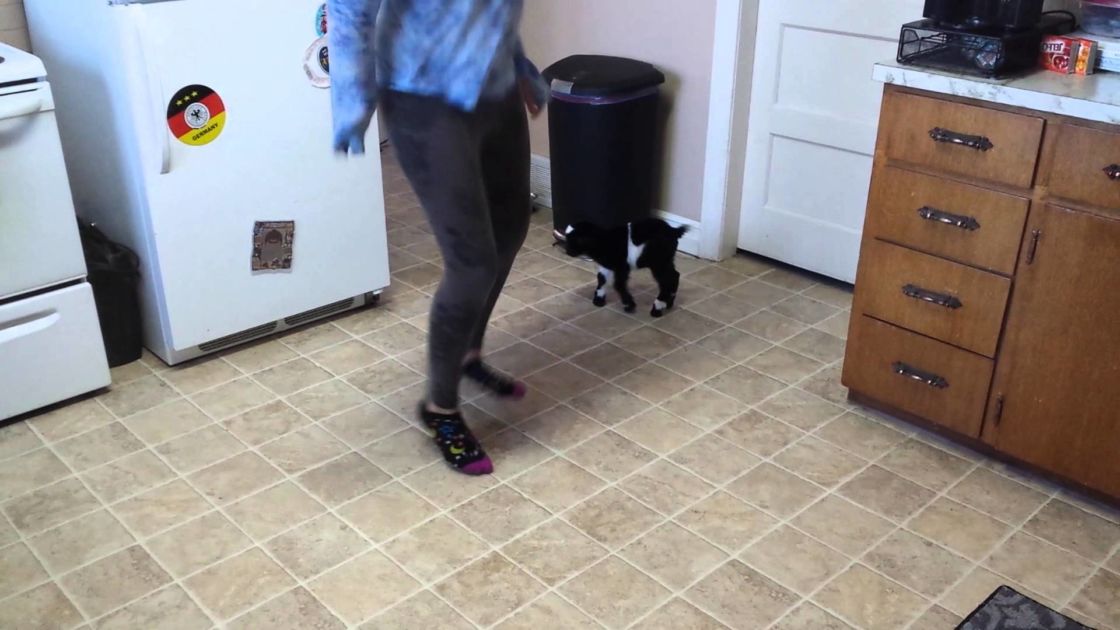What to feed baby raccoons without a mother
A raccoon is a RABIES VECTOR SPECIES! If you have found an orphaned or injured raccoon, you must be informed that RABIES in Texas is an ongoing state health emergency. It is illegal for a person to keep as a “Pet,” possess, or transport certain animals that are high risk for transmitting rabies, including raccoons, foxes, skunks, bats and coyotes. Until you are able to contact and place the orphan with a permitted Wildlife Rehabilitator, you can follow these CARE INSTRUCTIONS to give the infant the best chance for survival. HEAT & BEDDING: The very FIRST thing the orphaned raccoon kit will need is an external heat source. Infants younger than 5 weeks do not produce their own body heat to thermo-regulate. They need a heating pad, set on LOW setting. Place a bath towel, folded to make about a 1 to 1 1/2 inch thickness and put it on the heating pad. Now, place a box on top of the towel. Place your babies into a soft cloth such as an old flannel shirt, or old sweatshirt or sweatpants. Place the infant, nestled in the cloth, down into the box. That way, a gradual heat will come up through the layers and warm the infant, but not make them too hot. HOW OLD IS THE RACCOON? A 100-gram or less - baby is a week or less old: very light hair fuzz, 4 ½ -6” nose-end of tail, eyes closed, ears unopened, crawls spread-legged. DEHYDRATION: Dehydration is very common in orphan raccoons. A baby raccoon that is 5% dehydrated needs to get about 4-5% of its body weight of balanced fluids over an 8-hour period. A good rehydrating solution can be made by mixing the following: 1 pint of boiled (or distilled) water - 1 teaspoon of sugar - 1/3 teaspoon of salt. You can also rehydrate dehydrated babies with warm warmed Lactated Ringer's Solution (LRS) if available, or diluted Pedialyte, If the babies are not fed properly as infants, they may develop metabolic bone disease resulting in a horrid, painful death once released. Never give whole milk, raw eggs or honey to baby raccoons, as these could cause a deadly digestive bacterial infection. Keeping the baby hydrated and getting its electrolytes back in balance will suffice until it can be properly fed. Formula should be heated to body temperature before feeding (100-102F). You should feed it 5 times a day (that includes in the middle of the night) for the first four weeks. If it doesn't take to the bottle yet (animal nurser bottle, 4 ounce size, from a pet shop or a baby bottle with preemie nipple), Use a medication syringe and allow the baby to lick the formula off of the tip. FEEDING SCHEDULE (APPROXIMATIONS) HOW TO FEED: Use a baby bottle, warm the formula, and place the raccoon on its tummy. The raccoon will suck. You will have to clamp your hand firmly over its muzzle and rub its back to get the raccoon started. Make sure the hole in the nipple is not too large, as this will allow the raccoon to take too much formula. If this happens the raccoon will sneeze formula out of its nose – Stop feeding, turn upside down, gently rub its back, and gently wipe the excess formula from its nose. Repeat this for about 5 minutes or until the sneezing stops and breathing returns to normal. If severe this can cause immediate death or pneumonia on a long-term basis. To avoid this from occurring feed in a quiet room, go slowly and watch both the raccoon and the bottle. Feed the baby belly down on a towel or blanket on a counter top or on your lap; do not place it on its back, as this can cause aspiration leading to pneumonia and possible death. You will have to burp the baby, by laying it over your shoulder or lap and gently patting the upper neck, and manually stimulate it to eliminate for another few weeks. Use a warm rough paper towel and gently swap or tap the genital area from front to back. Place a soft piece of material between you and the baby so that you don't get dirty. WEANING DIET: (6 to 8 Weeks) You should be feeding 4 times a day now. TREATS (Sparingly) Fig Newton’s, cookies, wafers, raisins. LITTER BOX: Once a raccoon can walk, you can train it to use a litter-box. If you use a water bowl instead of a water bottle, the raccoon will eliminate in the water bowl. Practice proper hygiene at all times, as raccoons pass harmful parasites through their stools. On KMR, a normal stool is golden brown, with the consistency of peanut butter. Promptly flush any fecal matter down the toilet and immediately practice proper hygiene. Once the baby feeds from a dish, this should no longer be necessary WORM THE COON with Pyrantel Pamoate, orally at (5mg/pound) or 11mg/kg. Give NEMEX-2 @ weeks 2, 3, 4, 6, 8, 10, and then give 1 X monthly (Don’t be late)
Raccoons are the normal host for the parasitic roundworm (Baylisascaris procyonis). The macaroni-size roundworm is 5-8” long and pointed at both ends. It lives in the intestinal tract. The eggs are sticky and have a very tough shell, which is very difficult to destroy. Children may accidentally eat raccoon parasite eggs clinging to leaves or outdoor objects and toys. PARASITES are common in and on raccoons. Fleas are common on urban raccoons, ticks on wild ones. At this age, they are best picked off with tweezers and dropped into a jar of rubbing alcohol (the tick that is). Don't squish ticks – they carry nasty diseases. Rubbing a piece of cotton moistened with puppy/kitten flea spray (pyrethrins w/ pipronyl butoxide) will kill or immobilize fleas, but won't have much effect on ticks. DISEASE: Raccoons are considered a RABIES VECTOR SPECIES. They are also very susceptible to distemper. You may want to consider having the raccoon(s) vaccinated for distemper as well as against rabies. Pneumonia can be a real health threat in orphaned raccoons. An early sign of Pneumonia/Severe Upper Respiratory Infection is loss of appetite. If a coon refuses to eat, WATCH CLOSELY. Be prepared to start antibiotics VACCINES that have been safely used for raccoons include: HOUSING In Stages: 2 Wks to 7 Wks – Bathtub size crate or similar type enclose lined with old towels/linens. Heating pad under linens in one corner, or you can purchase 7 Wks to 9 Wks – Cage/Enclosure the size of a large birdhouse, with hammocks and limbs to climb on. Hang small coop cups on cage walls for food/water. 9 Wks to 11 Wks – Final Release Pen – At Least a 8’ X 8’ pen/enclosure with small pool and nest box(s). MUST BE ESCAPE PROOF top to bottom. Top of cage must be partially covered to protect from rain/sun overexposure. A tarp works well here. Larger coop cups for dog/cat food mixture and fruit. Insects and chicken necks, backs, gizzards (pressure cooked to soften bones) should be a part of diet at this age. Hollow logs are fun to play in when you can find them, tall tree limbs and connecting logs to encourage climbing skills. Use mulch or shavings on floor of cage for easier clean-up. They will need tree(s), child's wading pool, various climbing items and other toys, feeders, and wooden boxes for beds. They will stay in this type of enclosure until their final release. They should be released in an area with feeders that are regularly restocked until you are sure they no longer need them. You may show physical affection to nursing raccoons. You can then start to let them out by themselves, gradually building up from a few hours each day, to half a day, to overnight for a day or more at a time. Each time they visit their food bowl less and less, sustaining themselves on nature's offerings instead, and it becomes harder and harder to coax them to you. WHEN TO RELEASE If born in early spring (March to beginning of April), the raccoons may be ready for release by late August, if they are about 15lbs and wild they can be given a “soft” release from their cage. Otherwise the raccoons will not be ready to be released until the following spring, no earlier than mid May. |
Baby Raccoon - What you Need to Know
Raccoons just like most mammals are excellent mothers; they take good care of their young ones. When raccoon babies are born, they stay in the nest while the adult female raccoons go out to forage for food to help them produce enough milk to feed their young. After about 12 weeks of nursing, the baby raccoons are finally old enough to follow their mother out of their nesting area. During this time, they will learn from their mother how to forage for food, and where to look.
During this time, they will learn from their mother how to forage for food, and where to look.
Baby raccoons are dependent on their mother for up to nine months, after which they will go their way. The mother raccoons give birth to up to nine pups. After nine months she will only have two left, after which she will look for a new mate to make another litter during winter.
What do baby raccoons eat?
Raccoons are omnivorous; they will eat just about anything they get their paws on. However, baby raccoons are entirely dependent on their mothers’ milk. She often goes out to forage for food to be able to produce a sufficient amount of milk.
When baby raccoons are born, they are both blind and deaf for about the first three weeks but they grow very fast. During this period the baby raccoon will feed on its mother’s milk until it is old enough to follow her out of the nest. Raccoons nest in hollow trees or attics to keep their young safe. One of the main threats to baby raccoons is predators such as coyotes.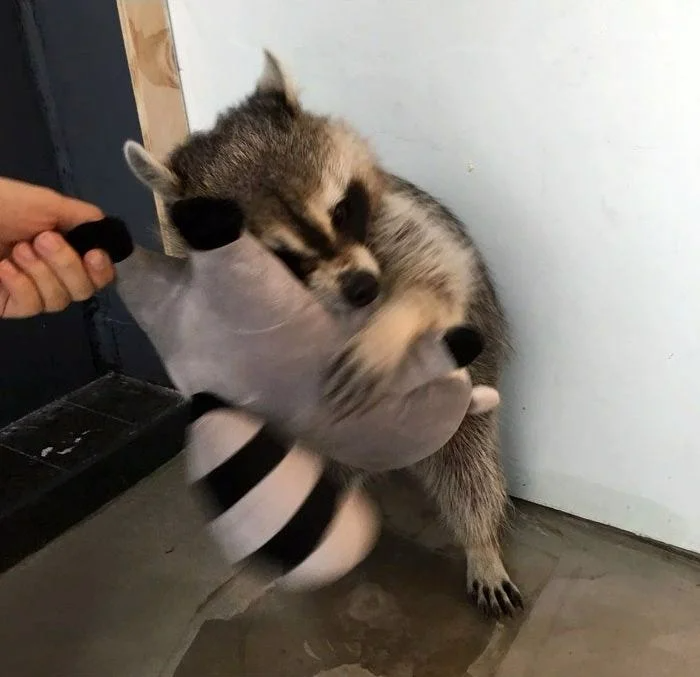 The young ones will stay with their mother through the first winter after which they will gradually leave.
The young ones will stay with their mother through the first winter after which they will gradually leave.
Caring for a baby raccoon isn’t an easy task for the mother. While they typically rely on milk, they have to be fed round the clock. Raccoon mothers feed their babies every four hours, that is at least five times a day. The mother raccoon spends most of her time in the nest attending to her young. The female has a duty of raising her young, and she does this all on her own.
After around six weeks, the baby raccoons are ready to start eating solid food. While they follow their mother and learn how to look for food, they are introduced to eating nuts, insects, fish, frogs, and berries. Raccoons are very adaptable animals, and after a few more weeks, they will slowly start going their way and will be less dependent on their mother.
Are baby raccoons dangerous?
A baby raccoon looks very similar to an adult raccoon, and the only distinguishing factor is its size. The newborns are deaf and blind for up to three weeks, and they are dependent on their mothers. If you have spotted a litter of raccoons on your property, you are probably wondering if they are dangerous.
The newborns are deaf and blind for up to three weeks, and they are dependent on their mothers. If you have spotted a litter of raccoons on your property, you are probably wondering if they are dangerous.
Well, while baby raccoons look cute and cuddly, it is important to note that they are wild animals, and could be potentially dangerous even at an infant stage. Baby raccoons are not yet old enough to be aggressive to bite and scratch, but their mother is. It is important that you only handle baby raccoons when you are certain their mother is not loose. Mother raccoons make awesome caregivers, and will not hesitate to attack humans close to their nests.
Raccoons are known to spread a variety of harmful diseases that could be transmitted to pets as well as humans. Therefore, when handling baby raccoons, you need to be extra careful. If you are unsure of yourself, contact your local wildlife service to get rid of them for you.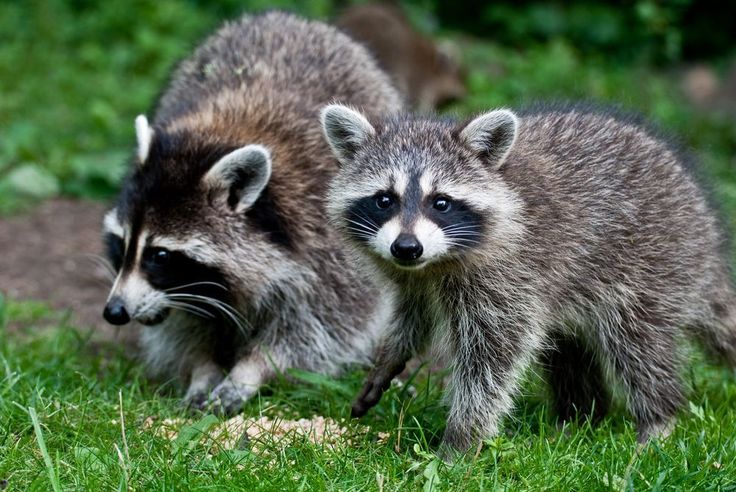 However, if you are willing to do it yourself, make sure you wear protective clothing which includes gloves, boots, a mask, and long-sleeved pants. Raccoon droppings often have parasites that can be transmitted to humans through contamination, soil, water, or by breathing dried-up particles of their droppings.
However, if you are willing to do it yourself, make sure you wear protective clothing which includes gloves, boots, a mask, and long-sleeved pants. Raccoon droppings often have parasites that can be transmitted to humans through contamination, soil, water, or by breathing dried-up particles of their droppings.
Baby raccoons could also be carriers of rabies. Raccoons are a vector carrier of rabies, and chances are the baby raccoons you are about to handle are also infected. Rabies is a viral disease that affects the central neural system and is usually spread through the bite of an infected animal. While the baby raccoon is incapable of biting you at a tender age, there have been cases of people going through rabies treatment after handling young infected babies. It is not only what the animals have but also what feces are left behind. Oftentimes feces removal is required after a raccoon and baby removal.
What do you call a baby raccoon?The correct name for a baby raccoon is a kit or a cub. Both these terms are widely used to describe baby raccoons.
Both these terms are widely used to describe baby raccoons.
However, a page on raccoons on the Smithsonian Museum of Natural History (Washington DC) website refers to raccoon babies as “cubs.” But the Canadian Wildlife Federation uses the term “kit,” as does the University of Pennsylvania, School of Veterinary Medicine.
So, either kit or cub is an acceptable moniker for a baby raccoon, depending on where you live.
When do baby raccoons leave the nest?Raccoon breeding season is anytime from December through to June, although most activity usually happens around February.
The mother raccoon is pregnant for between 63 and 65 days, giving birth to two to five babies in April or May. The newborn babies are helpless and blind until their eyes open at about three weeks of age. Between four to six weeks, the baby raccoons begin to stand and learn to move around the den. Sometimes, the mother carries her babies one by one in her mouth until they are fully mobile.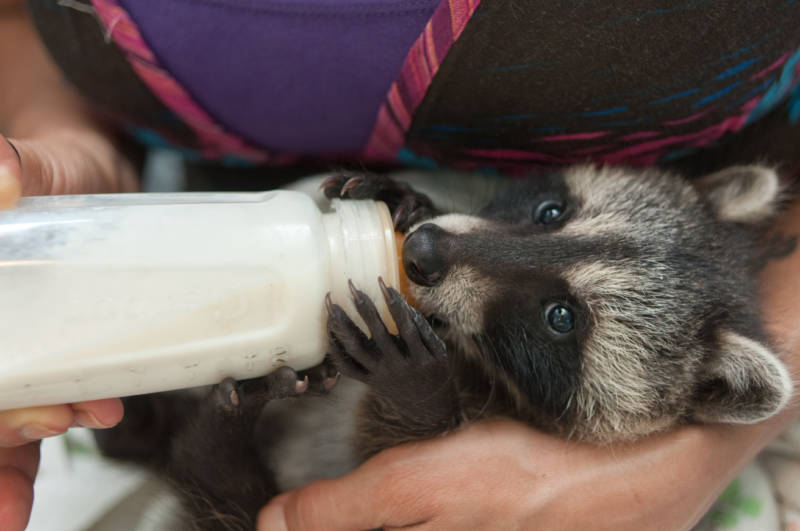
Once they reach eight weeks old, the baby raccoons typically leave the den and follow their mother to a new location. During that time, the mother teaches her family how to forage for food. Raccoon fathers do not play a role in raising their young; that task falls exclusively to the babies’ mother.
How long do baby raccoons stay with their mother?Baby raccoons are weaned off their mother’s milk when they are about 12 weeks old. Occasionally, the youngsters disperse during the fall or early in the winter of their first year, but it is more usual for the babies to overwinter in a den with their mother until the following spring. Raccoons don’t hibernate, preferring to huddle together as a family in their den until the harsh winter weather abates.
Unlike some species, raccoons raise their young in isolation, and they do not have babysitters for their youngsters. So, that means busy raccoon mothers do have to leave their family unattended for quite long periods of time while they go foraging for food. Older baby raccoons often become adventurous, venturing out of the den while mom is absent. That’s usually when homeowners come across a baby raccoon and assume it’s been orphaned, which is most likely not the case at all.
Older baby raccoons often become adventurous, venturing out of the den while mom is absent. That’s usually when homeowners come across a baby raccoon and assume it’s been orphaned, which is most likely not the case at all.
Once the baby raccoons reach ten months of age, they will be independent. At that time, the youngsters, especially females, will often decide to build dens close to their mother. So, during the spring, many young raccoons are searching for a suitable den site in which to raise their own families, which could include your walls, attic, or chimney.
What does a raccoon nest look like?Although they do nest in trees, the perfect place for raccoons to nest and raise a family is the sheltered, warm environment of your attic or some other area in your home.
Squirrels also like to take up residence in attics and are just as big a nuisance as raccoons. But how can you tell the difference between a raccoon nest and a squirrel nest?
Raccoons build a bed, rather than a nest, and these resourceful creatures are not fussy about what they use for nesting materials.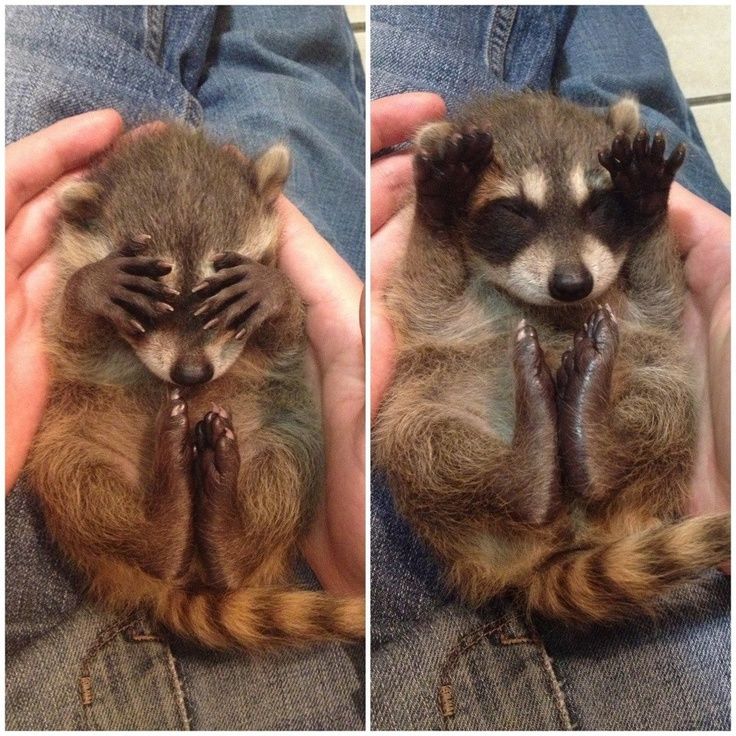 The most commonly used nesting materials for outdoor-dwelling raccoons are hay and long grass.
The most commonly used nesting materials for outdoor-dwelling raccoons are hay and long grass.
However, away from the elements inside the haven of your attic, raccoons are quite happy to use your insulation to create a cozy bed. A mother raccoon can wreak havoc in your home by shredding your insulation until she has a pile of material that’s deep enough to burrow inside. Given that adult raccoons grow to the size of a small dog, that’s a lot of insulation!
A squirrel nest tends to be more intricately constructed than that of a raccoon, but it isn’t very easy to tell the difference if you don’t have a trained eye. For that reason, you are strongly advised to ask a professional wildlife relocation service contractor to take a look at the nest for you.
What to do if you find an injured baby raccoon
It’s not uncommon to find baby wild animals outside, especially during spring going about their business. Most people often find the need to help baby raccoons when they find them alone on their property.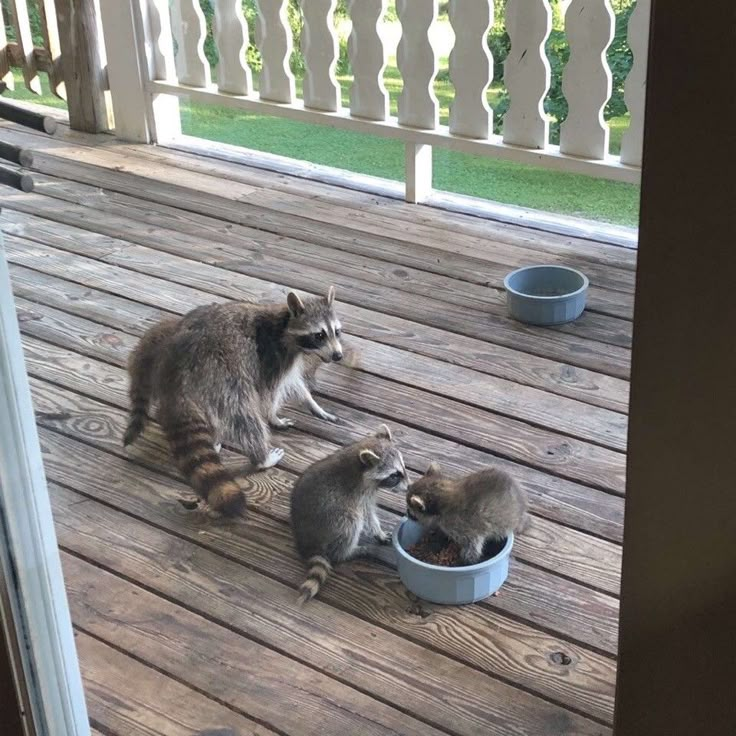 However, while they might seem like they need our help, you should not take that step until you are 100% certain.
However, while they might seem like they need our help, you should not take that step until you are 100% certain.
How will I tell if the baby raccoon is Injured or needs my help?
A baby raccoon needs your help if:
- It is presented to you by a cat or a dog
- You can see there is evidence of bleeding
- You spot an apparent or obvious broken limb
- The baby raccoon is shivering
- There is a dead parent nearby
- The baby raccoon is wandering and crying all day.
If you find a baby raccoon in any of the above conditions, the first thing you need to do it to keep it contained. This gives you time to figure out how you will help it. It’s important to wear protective clothing before handling any raccoon even at a tender age. If you are unsure of how to handle it, call our raccoon removal Scarborough service to help you out. https://youtu.be/NIQ7n_rhMYs
Baby Raccoon Removal Process
Approach the baby raccoon from behind and drop a towel on the animal, make sure it covers the body as well as the head and immediately place it in a container.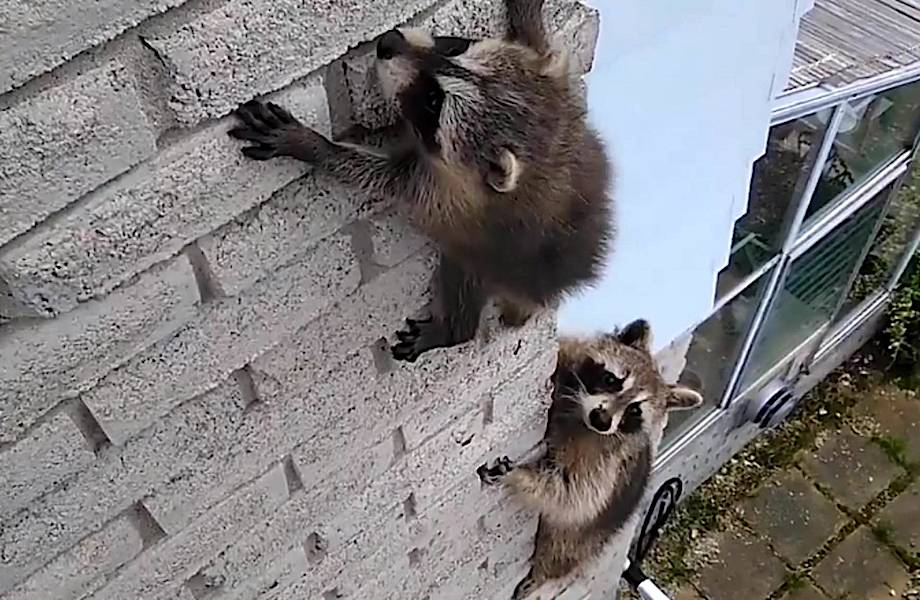 Seal or cover the container to prevent it from getting away.
Seal or cover the container to prevent it from getting away.
Smaller baby raccoons
If the raccoon in question is about three weeks old, put it in a cardboard box with a t-shirt or a soft towel to keep it warm and cozy. It doesn’t matter how hot it is outside; baby raccoons get cold, offer it a heat source.
Larger baby raccoons
Larger baby raccoons can be lured or put into a dog or cat crate. You could also place a laundry basket or cardboard box over them. Reinforce this by placing something heavy on top to reduce movement. Keep the baby raccoon in a warm dark, quiet place. Do not feed it, and call your local wildlife service right away.
Can I transport the injured baby raccoon?
Depending on where you find the injured raccoon, you could transport it to the nearest animal facility including:
- A wildlife rehabilitator
- Local veterinary clinic
- Local animal control agency
Remember, when transporting the animal, ensure that it is safely secured in a cardboard box or crate.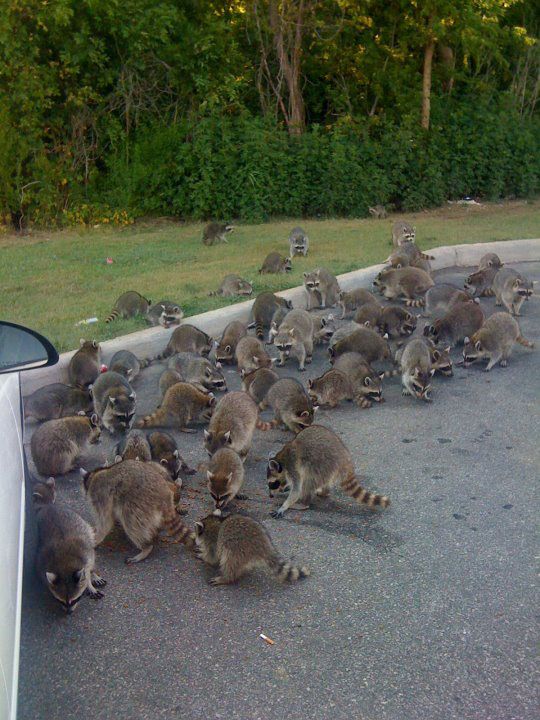 Also, ensure the car is as quiet as possible. Raccoons hate noise, if possible, avoid turning on the radio. We highly recommend that you do not transport or handle baby raccoons on your own. Raccoons carry parasites that could be passed on to you and your pets. Having a baby raccoon in your car or household could potentially expose you and your family to diseases.
Also, ensure the car is as quiet as possible. Raccoons hate noise, if possible, avoid turning on the radio. We highly recommend that you do not transport or handle baby raccoons on your own. Raccoons carry parasites that could be passed on to you and your pets. Having a baby raccoon in your car or household could potentially expose you and your family to diseases.
How to reunite an injured baby raccoon and mother
Sometimes, during nursing, a baby raccoon can fall out of its nest and get separated from the rest of the litter. If you spot such a raccoon, first check if it is injured, in case it isn’t, the best possible option is to get it back to its mother. Raccoons just like most mammals make excellent mothers and will come back looking for its baby if given a chance. An adult female raccoon will take care of its baby better than any human or wildlife care center could do.
Baby Raccoon and GarbageWear protective clothing, and safely secure the raccoon into a cardboard box with a heat source.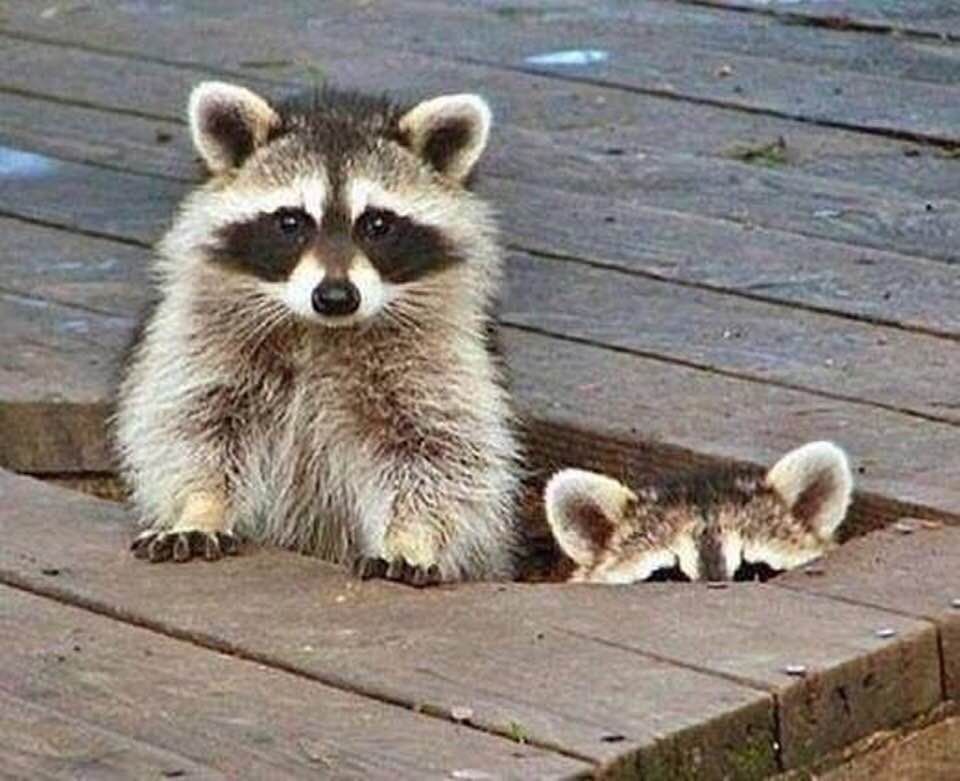 Place it as closely as possible to where the baby raccoon was discovered. In case there is a tree in the vicinity, place it at the base of the tree. Raccoons will rarely nest at trees, placing it next to a building or structure will work too. If you know where the raccoon nest is, place the box near the raccoon trail leading to the nest. During this process, do not wear perfume or have any fragrance that will deter the mother raccoon away.
Place it as closely as possible to where the baby raccoon was discovered. In case there is a tree in the vicinity, place it at the base of the tree. Raccoons will rarely nest at trees, placing it next to a building or structure will work too. If you know where the raccoon nest is, place the box near the raccoon trail leading to the nest. During this process, do not wear perfume or have any fragrance that will deter the mother raccoon away.
The baby raccoon should be left for a full night to see if the mother will rescue it. Raccoons are nocturnal animals, and will most likely come out in the cover of the night to look for its young when it’s most active. Ensure that the box enclosure is warm, and if possible, refresh your heat source. It’s also important that you do not attempt to feed the raccoon. Keeping the baby raccoon hungry is key to getting the mother to find it. A hungry baby raccoon just like a human child will cry when hungry calling its mother.
If you live in a noisy area, you could leave a sign next to the cardboard box, letting others know that the baby raccoon is waiting for its mother. Alternatively, you could take the baby and place it in a dark, secure location until sunset when everything cools down. Remember, you need to leave the baby raccoon out for a single full night to give the mother a chance to find it.
Alternatively, you could take the baby and place it in a dark, secure location until sunset when everything cools down. Remember, you need to leave the baby raccoon out for a single full night to give the mother a chance to find it.
In case the mother doesn’t come back for the baby after leaving it outside for a full night, the baby could probably be an orphan. Its rare for a mother raccoon to abandon it’s young, however, if something happens to the mother while she’s out foraging, she might not be capable of getting back to her litter. In such a scenario, contact your local wildlife removal service for advice. All these factors can impact raccoon removal prices.
What do you do when you find an abandoned baby raccoon?
Sometimes, baby raccoons and mothers get separated due to different reasons. If you bumped into a baby raccoon in your property without its mother, the first thing you need to do is access its well-being. Check if:
- The baby is cold or lethargic
- Is the baby raccoon coat patchy or matted?
- Is its head tilted?
- Is it bleeding?
- Does it have any broken limbs?
- Did you find the dead mother?
- Does the baby raccoon have abrasions?
If the answer to the above questions is yes, then reuniting the baby raccoon back to its mother is no longer an option. The baby raccoon will need to get to a wildlife rehabilitation center immediately.
The baby raccoon will need to get to a wildlife rehabilitation center immediately.
What scenario would make a baby raccoon an orphan?
- Sometimes the babies get trapped inside the nest, and the mother is unable to get to them.
- In rare cases, the mother abandons the baby with reasons best known to her; sometimes, she is unable to provide to all her babies.
- Mother was trapped and relocated or killed, and the babies were found later
- The mother was in the process of moving the babies to a new nest, but she can only carry one pup at a time.
When you find the abandoned baby raccoon, regardless of the time of the year, make sure that the babies are warm to the touch before you get to reunite them. You could use a warm water bottle with a sock to keep warm. Make sure the water bottle doesn’t get cold. When the water bottle gets cold, it will suck the warmth out of the babies. Also, do not attempt to feed the raccoons. If you are certain that the mother has abandoned them, and you have left them out for a whole night without rescue, call your local wildlife removal service or animal control. Avoid handling the raccoons with your bare hands, and keep them out of reach from pets and children. Raccoons often have parasites, and they could easily transfer them to you when you handle them.
If you are certain that the mother has abandoned them, and you have left them out for a whole night without rescue, call your local wildlife removal service or animal control. Avoid handling the raccoons with your bare hands, and keep them out of reach from pets and children. Raccoons often have parasites, and they could easily transfer them to you when you handle them.
Update Articled: January 23, 2020
How to feed a raccoon puppy | House of the Raccoon
Tiny
So, the long-awaited baby is home! What's next? How to feed a raccoon puppy ? What else is needed for him to survive and grow up healthy and cheerful? In short, the following is required: 1) Determine the approximate age of puppy and, more importantly, its development. 2) Feed correctly 3) Do massages 4) Provide a comfortable temperature and a safe place
Only puppies older than 2 weeks can be kept like this during feeding! NOTE!
Raccoon
All these moments are very important for the survival and rearing of the baby raccoon .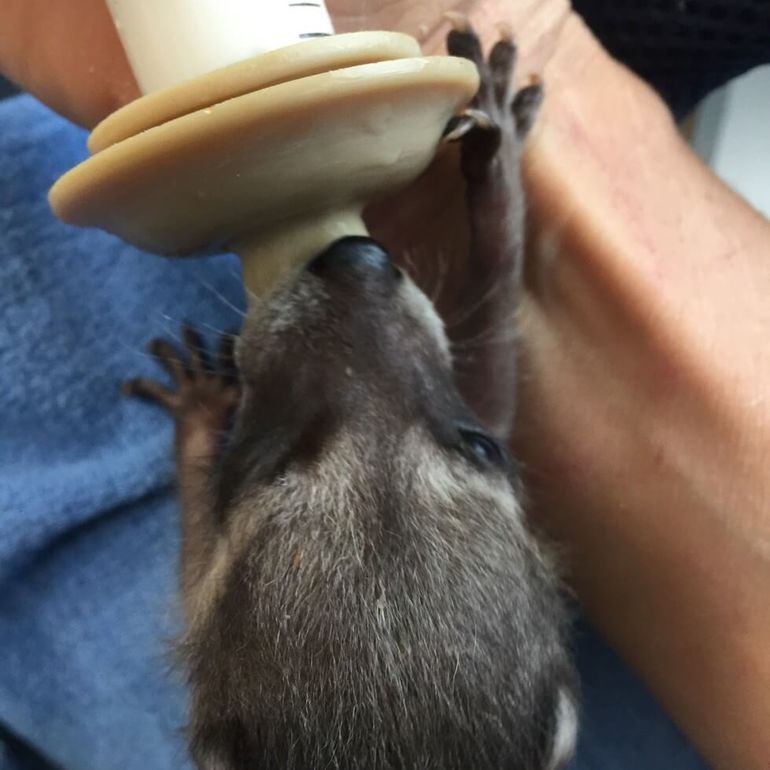 None of them can be passed over as less significant. Let's take a look at each of these points in order and in as much detail as possible. So definition of age and development. Everything else depends on this. The age of a raccoon and its development are two different factors. In dogs and cats, most often the specific age of the puppy implies a specific development. In raccoons the situation is much more complicated. For example: Last year, one owner had two females at about the same time brought raccoon puppies . The conditions of keeping, feeding and care for both female raccoons were the same. Only the age of females and males-fathers of raccoon puppies differed. At the age of 3 weeks, the puppies of both females were about the same size, weight and behavior. But by 5 weeks, weight and behavior began to differ significantly. The babies of the first female at 5 weeks old began to open their eyes and actively crawl around the den. The second mother's children began to open their eyes only at 8 weeks.
None of them can be passed over as less significant. Let's take a look at each of these points in order and in as much detail as possible. So definition of age and development. Everything else depends on this. The age of a raccoon and its development are two different factors. In dogs and cats, most often the specific age of the puppy implies a specific development. In raccoons the situation is much more complicated. For example: Last year, one owner had two females at about the same time brought raccoon puppies . The conditions of keeping, feeding and care for both female raccoons were the same. Only the age of females and males-fathers of raccoon puppies differed. At the age of 3 weeks, the puppies of both females were about the same size, weight and behavior. But by 5 weeks, weight and behavior began to differ significantly. The babies of the first female at 5 weeks old began to open their eyes and actively crawl around the den. The second mother's children began to open their eyes only at 8 weeks. And active crawling out of the lair began at 9weeks. The babies of the first female at that time already saw perfectly well, kept well on their paws and began to try food from their mother's bowl. They were painlessly transferred to soaked dry food for small puppies under the mother at 7 weeks. The babies of the second mother, up to 12 weeks, had to be bottle-fed with a milk-banana mixture, and only by 16 weeks they began to eat solid food and firmly stood on their paws. This is the difference I have in mind when I talk about development. So, we examine our baby: 1) how confidently does he hold on to his paws, does he completely raise the body above the ground or do the paws spread and only sometimes does the baby collect them under him? Until the baby fully confidently stands on its paws, it will have to be fed from a bottle with a banana-milk mixture. Not to be confused with braiding the paws while moving! For a long time, the baby will learn to control them, especially when cornering, but he must confidently keep his body on them.
And active crawling out of the lair began at 9weeks. The babies of the first female at that time already saw perfectly well, kept well on their paws and began to try food from their mother's bowl. They were painlessly transferred to soaked dry food for small puppies under the mother at 7 weeks. The babies of the second mother, up to 12 weeks, had to be bottle-fed with a milk-banana mixture, and only by 16 weeks they began to eat solid food and firmly stood on their paws. This is the difference I have in mind when I talk about development. So, we examine our baby: 1) how confidently does he hold on to his paws, does he completely raise the body above the ground or do the paws spread and only sometimes does the baby collect them under him? Until the baby fully confidently stands on its paws, it will have to be fed from a bottle with a banana-milk mixture. Not to be confused with braiding the paws while moving! For a long time, the baby will learn to control them, especially when cornering, but he must confidently keep his body on them.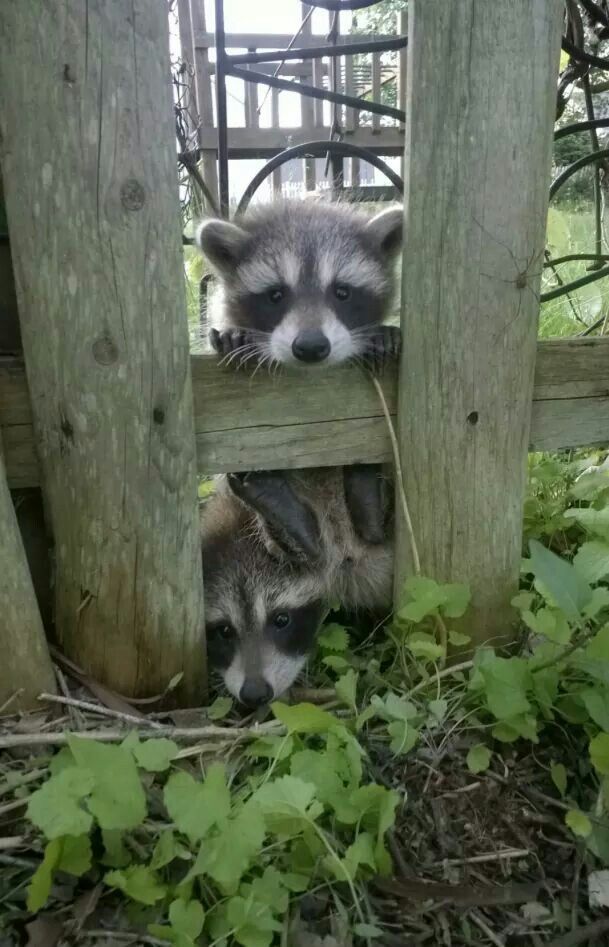 2) Eyes. Only if the baby has clean, without blue lanyards, completely open, meaningfully looking eyes, can he be fed “in an adult way”. If there is an infantile languor (blueness) on the eyes, if the gaze is wandering and inattentive, your food is in the bottle. So, we have formed two types of baby's age: for a bottle and for soaked food. And you can’t confuse them, ruin the baby! While the baby is feeding from a bottle, your obligatory worries are added: 1) Sterilization of the bottle 2) Massage of the tummy and anus until the result. 3) Temperature control
2) Eyes. Only if the baby has clean, without blue lanyards, completely open, meaningfully looking eyes, can he be fed “in an adult way”. If there is an infantile languor (blueness) on the eyes, if the gaze is wandering and inattentive, your food is in the bottle. So, we have formed two types of baby's age: for a bottle and for soaked food. And you can’t confuse them, ruin the baby! While the baby is feeding from a bottle, your obligatory worries are added: 1) Sterilization of the bottle 2) Massage of the tummy and anus until the result. 3) Temperature control
where to buy a raccoon
DO NOT hold the baby during feeding!!!!
4) Sucking reflex compensation (finger). At this age, babies are not yet able to regulate their body temperature. Easy to catch cold and overheat. This issue is best solved by placing the raccoon in a rather large cardboard box with high walls. We cover the box with terry towels. In one of the corners we put plastic one and a half liter bottles with warm water. When the baby is cold, he will climb into this corner. Bottles can be replaced with heating pads. But do not forget, firstly, to change the water more often as it cools down, and secondly, make sure that the baby has somewhere to crawl if it gets hot. These recommendations do not apply to babies who do not actively crawl themselves. How to deal with them, I will tell separately. Feeding babies : So, very young babies, before opening their eyes, you can try to feed them with cat's milk replacer. NEVER FEED MILK!! This applies to all types of milk: cow's, goat's, lactose-free... There were cases of successful nursing in Russia, but there were also sad stories. Therefore, I decided to clarify this issue with foreign colleagues from the Forest Infant Rehabilitation Center in Canada. Their advice can be read here. Not every mixture is suitable - a milk replacer. In Russia, it is desirable to find one. If there are discrepancies in the articles, please clarify in the comments: now we are closely studying this issue.
When the baby is cold, he will climb into this corner. Bottles can be replaced with heating pads. But do not forget, firstly, to change the water more often as it cools down, and secondly, make sure that the baby has somewhere to crawl if it gets hot. These recommendations do not apply to babies who do not actively crawl themselves. How to deal with them, I will tell separately. Feeding babies : So, very young babies, before opening their eyes, you can try to feed them with cat's milk replacer. NEVER FEED MILK!! This applies to all types of milk: cow's, goat's, lactose-free... There were cases of successful nursing in Russia, but there were also sad stories. Therefore, I decided to clarify this issue with foreign colleagues from the Forest Infant Rehabilitation Center in Canada. Their advice can be read here. Not every mixture is suitable - a milk replacer. In Russia, it is desirable to find one. If there are discrepancies in the articles, please clarify in the comments: now we are closely studying this issue.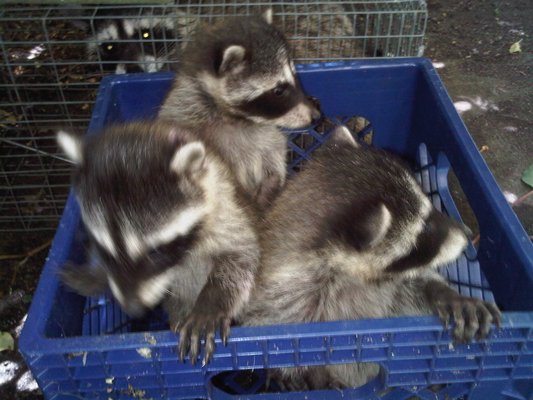
Here it is important not to overfeed the baby, but also not to starve. After feeding, the raccoon puppy should calmly sleep sweetly for 3-4 hours. If he wakes up earlier, you are underfeeding; if he sleeps further, you are overfeeding. Daily weighing is not unimportant! Weight must always increase! Let just a little, but grow. Therefore, you will definitely need electronic scales. Also during this period, massage of the tummy and perineum is especially important. Enetenok himself can neither write nor poop. Massage of the tummy is performed immediately after feeding and in the interval between feedings. The massage is performed as follows: with soft circular movements clockwise we stroke the tummy, slightly pressing. After two or three minutes of massage, lift the ponytail almost perpendicular to the back and slap the anus with gentle movements, lifting the ass with an upward movement. In case of constipation, first lubricate the ass with plenty of Vaseline. Next, we put the raccoon on the palm, so that the index finger is on the raccoon's pussy, and pat it until urination. Ideally, the chair should be after each feeding. And if this does not happen, we repeat the massage every 40-50 minutes until the result. The main thing is that the tummy is soft and painless. In case something worries you, read "first aid for a baby: tummy hurts." If the baby drinks 40 ml of milk, eagerly, without releasing the bottle, but sleeps for only an hour and wakes up again, there is a reason to increase the nutritional value of milk. In each feeding, we begin to add a slice of banana to milk, we start with a piece of banana 1 cm thick. The next feeding is already 3 cm and if diarrhea does not appear, in the next feeding we already make a mixture of half a banana and 100 ml of milk. If the baby is weakened, leave the banana share small and add 1 tablespoon of rice water. Banana + milk - the main mixture for feeding a baby raccoon of the first period of development. When loose stools appear, a spoonful of rice broth or a spoonful of oak bark decoction is added to the mixture. If mucus appears in the stool, an admixture of blood, or it has acquired a green color or a fetid odor, these are good reasons to see a doctor.
Ideally, the chair should be after each feeding. And if this does not happen, we repeat the massage every 40-50 minutes until the result. The main thing is that the tummy is soft and painless. In case something worries you, read "first aid for a baby: tummy hurts." If the baby drinks 40 ml of milk, eagerly, without releasing the bottle, but sleeps for only an hour and wakes up again, there is a reason to increase the nutritional value of milk. In each feeding, we begin to add a slice of banana to milk, we start with a piece of banana 1 cm thick. The next feeding is already 3 cm and if diarrhea does not appear, in the next feeding we already make a mixture of half a banana and 100 ml of milk. If the baby is weakened, leave the banana share small and add 1 tablespoon of rice water. Banana + milk - the main mixture for feeding a baby raccoon of the first period of development. When loose stools appear, a spoonful of rice broth or a spoonful of oak bark decoction is added to the mixture. If mucus appears in the stool, an admixture of blood, or it has acquired a green color or a fetid odor, these are good reasons to see a doctor. The ways of feeding the baby of the first period of development are varied and are selected from the preferences of the baby. Someone successfully learns to suck a nipple on a bottle, someone can be fed only from a syringe without a needle and kutya, someone begins to lap from a saucer, getting into it with all four paws. In Canada, feeding through a wheat straw or a cocktail tube directly from the owner's mouth is popular. Raccoons are stubborn and stubborn. And that's how they are born. And no hunger will make a youngster suck a pacifier if he doesn't like it. The first attempts in any case will take place with a fight and squeals. But if you are attentive and patient, you will quickly feel for yourself exactly how, in what way your baby agrees to eat. I wish you success.
The ways of feeding the baby of the first period of development are varied and are selected from the preferences of the baby. Someone successfully learns to suck a nipple on a bottle, someone can be fed only from a syringe without a needle and kutya, someone begins to lap from a saucer, getting into it with all four paws. In Canada, feeding through a wheat straw or a cocktail tube directly from the owner's mouth is popular. Raccoons are stubborn and stubborn. And that's how they are born. And no hunger will make a youngster suck a pacifier if he doesn't like it. The first attempts in any case will take place with a fight and squeals. But if you are attentive and patient, you will quickly feel for yourself exactly how, in what way your baby agrees to eat. I wish you success.
feeding raccoon puppies
| Age (weeks) | Feeding formula | Important | Special care |
| Birth to 1 week 60-140 grams Eyes and ears closed muzzle mask and tail rings barely visible scanty fluff of fur on the back and sides, no fur on the belly
| Serving 3 - 7 ml. nutrition (this is approximately 5% of body weight) 7-8 times a day every 2.5 - 3 hours, including night feedings. An example of a feeding schedule for 8 times a day: 7:00,9:30, at 12 :00, 14:30, 17:00, 19:30, 22:00, plus once during the night. nutrition (this is approximately 5% of body weight) 7-8 times a day every 2.5 - 3 hours, including night feedings. An example of a feeding schedule for 8 times a day: 7:00,9:30, at 12 :00, 14:30, 17:00, 19:30, 22:00, plus once during the night. Example of a feeding schedule for 7 times a day: 7:00, 10:00, 13:00, 16:00, 19:00, 22:00, plus one during the night. Feeding formula should be warmer than body temperature as it cools quickly as it passes through the nipple or feeding syringe, so keep the feeding bottle in a larger cup of warm water while feeding. | Keep baby warm in a pet carrier or small closed box with breathing holes. Protect them from drafts, and create a cozy nest with several layers of soft fabric. Change bedding twice a day, and wash them without using rinse aid because the smell is bad for babies' respiratory system. Provide outside warmth by putting a heating pad or a bottle of warm water wrapped in a soft cloth. Make sure it doesn't leak and isn't too hot for the baby to cuddle up with. Change before next feeding or when cool. Change before next feeding or when cool. | Keep baby warm at all feeding times by wrapping in a warm cloth, cage or box at all times with a heating pad or hot water bottle. Feed him in a quiet, warm environment with no distractions. Try to provide extra sucking time by wearing latex gloves over light cotton gloves and letting them suck your fingers for 10 or 15 minutes after each feed. Stimulate him at every feed by gently stroking the genital area with a wet finger or Q-tip or soft damp cloth until he has finished urinating and/or defecation. Thoroughly wash face, neck and chin after each feeding. After the baby has digested the food, the stool should be formed and golden brown. Maintain proper hygiene, as raccoon feces can contain parasites. |
| 2 weeks190-225 grams slightly pubescent no belly fur Eyes and ears closed | Serving 9.5 - 11.3 ml nutrition (that's about 5% of body weight) 6 times a day every 3 hours Example of a feeding schedule for 6 times a day: 7:00, 10:00, 13:00, 16:00, 19:00, 22:0 |
Same as |
Same as |
3 weeks 320-400 gr.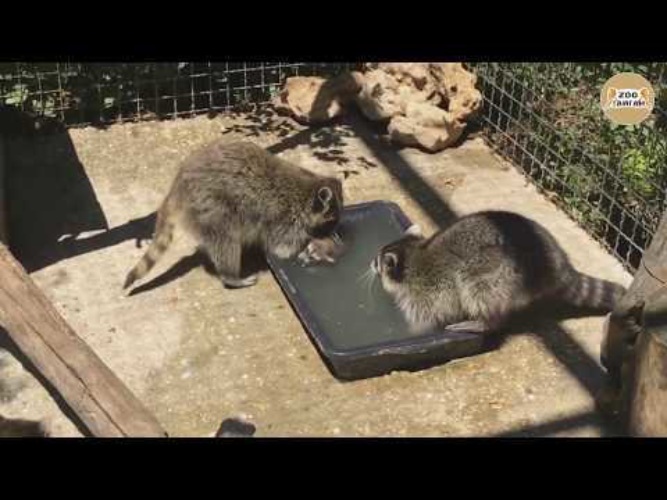 full fur Eyes open at about 3 weeks (18 to 24 days of age)
| Serving 16 - 20 ml nutrition (that's about 5% of body weight) 6 times a day every 3 hours | Same as | The same Since babies become more inquisitive after opening their eyes, it is important to continue feeding them in a quiet room without any distractions. Babies can already suck from a bottle on their own. If you have several babies, you can secure several bottles on a wooden base with rubber rings. |
| 4 weeks450-550 grams
| Serving 22.5 - 27.5 ml nutrition (5% of body weight) or Serving 31.5 - 38.5 ml (7% of body weight) 5 times a day every 3.5 hours Example of a feeding schedule for 5 times a day: 7:00, 10:30, 14:00, 17:30, 21:00 | Same as | Same as |
| 5 weeks600-700 grams | Serving 30-35 ml nutrition (5% of body weight) OR Serving 42 - 49 ml (7% of body weight) 4 times a day every 4 hours Example of a feeding schedule for 4 times a day: 7:00, 11:00, 15:00, 19:00 | Same as | After a week or two of babies have opened their eyes, they can urinate on their own, you can start to teach them to go to the toilet on paper towels. You can encourage them to urinate so they know where to go. Constantly monitor the cleanliness in the cage, change paper towels in a timely manner. You can encourage them to urinate so they know where to go. Constantly monitor the cleanliness in the cage, change paper towels in a timely manner. |
| 6 weeks750-820 grams | Serving 37.5 - 41ml nutrition (5% of body weight) OR Serving 52.3 - 55.4 ml (7% of body weight) 4 times a day every 4 hours Example of a feeding schedule for 4 times a day: 7:00, 11:00, 15:00, 19:00 Solid foods, good quality puppy food and cut fruit (grapes and bananas are preferred) may be introduced. Soak puppy food with nutrition first or mix banana puree with nutrition. Heat in the microwave until the granules are completely dissolved.
| Provide a source of clean drinking water, wash a cup of water several times a day and change the water. | You can use sand or kitten litter for potty training. The cage and tray should be cleaned and washed frequently, and the bedding should be changed daily. |
| 7 weeks900-1000 grams | Serving 45 - 5 0ml nutrition (5% of body weight) OR Portion 63 - 70 ml (7% of body weight) 4 times a day every 4 hours Example of a feeding schedule for 4 times a day: 7:00, 11:00, 15:00, 19:00 After they eat puppy food, stop soaking it and increase the amount of solid food. | Same as | Same as |
| 8 - 10 weeks 1000-1450 g | Serving 50 - 72.5ml nutrition (5% of body weight) OR Serving up to 80 ml per feeding 3 times a day every 5 hours Example of a feeding schedule for 3 times a day: 8:00, 13:00, 18:00 | Same as | Weaning Note: Do not increase feed volume above 80 ml, feed more solid food, and if the raccoons are not fed, they will be forced to eat solid food. |
| 10 - 16 weeks Raccoons born in the spring (March - May) should weigh about 6-7 kg by August-September at 16-18 weeks. | Feeding puppy food (about 2/3 of the diet) and fresh fruits and vegetables (about 1/3 of the diet). Adult dog food does not meet all the needs of a growing animal. | In the cage, make hammocks from hard fabric and ropes, various climbing frames, hang swings from tires. |
You can read more about keeping raccoons at home in the book "Poloskun Raccoon" https://ridero.ru/books/enot-poloskun/
What do raccoons eat - What do they eat on planet Earth
Raccoons are omnivorous and their diet is very diverse. They prefer to live in forested areas near water sources, but often come to settlements in search of food. The composition of his food depends on its availability.
The composition of his food depends on its availability.
What raccoons eat in nature
In nature, they prefer to eat the following foods:
- crayfish, frogs, fish, snails and shellfish;
- insects, eggs, fruits, vegetables, nuts and even dead animals.
They do not know how to hunt, but sometimes they manage to catch a mouse, a rat or a squirrel.
In North America they can catch baby alligators and destroy turtle nests.
Raccoons lead a solitary lifestyle, except for the mating period. They usually search and eat food at night.
They eat a lot in order to accumulate a supply of fat for the winter, in winter they spend most of their time in a hole.
They have five toes and two front paws, which they have learned to use well for getting food. The fingers are equipped with sharp claws, they use them to capture their prey both on land and in water. With them, they can dig up the ground in search of food.
They have many sensitive sensory receptors on their front paws, which allows them to conveniently sort garbage and easily open the lids of garbage cans.
What raccoons eat in the city
These animals are often found in cities and gardens. They steal grown fruits and vegetables, rummage through garbage and eat leftover food left over from human activities.
In the city, their diet usually includes everything edible that can be found in the garbage, these are the remains of vegetables, fruits, meat, pizza and cheeseburgers.
They only refuse spicy food. Unfortunately, such food greatly harms them, studies have been conducted on city raccoons and it has been found that they have high blood sugar levels, which leads to diabetes and premature death.
Researchers also found things like cigarette butts, plastic and other waste in their litter, which he probably eats unintentionally.
What domestic raccoons eat
Raccoons make interesting pets, but just like meerkats, they are very destructive and difficult to keep. They are curious, mischievous, playful and understand everything.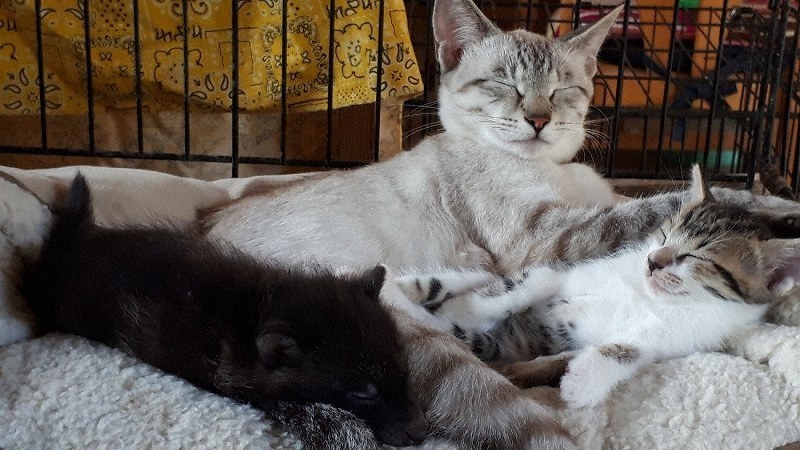
At home, they should be fed a varied diet. Ready-made food is not produced for them, so the owner should deal with their diet on their own.
Since they are omnivorous, they should be given different foods and little by little. Their diet should be changed from season to season, somewhere to give more vegetable food, and sometimes more animal.
Most of their diet consists of worms, insects and other invertebrates, as well as plant foods, including fruits.
Foods such as small reptiles, amphibians, birds and other vertebrates form a small part of their diet.
A typical pet raccoon diet is:
- Daily, grain-free dog food;
- In addition to food, they should be given poultry, fish, eggs, as well as fresh vegetables, fruits and whole prey, such as mice.
Do not feed them dog food alone. Live crickets, mealworms and other invertebrates should be added to the feed.
Nuts and seeds should be given to him as a treat, due to their high fat content.
A young raccoon should not be limited in the amount of food, let him eat as much as he can eat. When they reach six months, the amount of feed should be limited.
Quality grain-free dog food is usually high in calories, so giving him a small handful or 1/8 cup two to three times a day is enough.
A few cloves of vegetables or fruits and eggs, chicken, insects should be added to the feed, all of which are given in small quantities.
If you notice that the raccoon's waist is disappearing and you cannot feel the ribs, reduce the amount of food and put him on a diet.
These animals like to dip their food in water before eating it, why they do this is not known, but provide them with such an opportunity.
They are very dirty eaters, so feed them in a tray or pan, otherwise your floor will be very dirty.
They can be fed from a bowl, but it is better to imitate the search for food, as in nature. Spread the food in different places so that he trains his brain and body.
Raccoons, like other animals, are harmful and dangerous to human food, they do not eat spicy food.
What do raccoons eat in winter
The diet of raccoons varies with the season and food availability during these periods. In winter, they switch to smaller mammals, as plant food sources are not available to them. In some countries where plants grow in winter, they may begin to consume them as well, in particular prickly pear or lavender, which they never eat in summer.
If they can't find food in winter, then nothing happens to them, they just sleep in their lair, getting energy from fat accumulated over the summer. Raccoons do not fall into constant winter hibernation, as some other animal species do.
Without food, a raccoon can spend up to several weeks in its den, which allows them to survive it relatively comfortably on a small amount of food. During the winter, they usually lose up to 50% of their weight.
FAQ
What newborn raccoons eat
A newborn raccoon feeds on mother's milk for about 16 weeks, after which it begins to eat normal food. Orphans are fed milk formulas for kittens.
Orphans are fed milk formulas for kittens.
But if you meet a baby raccoon without a mother, then before you help him, follow the safety rules:
- If you notice a raccoon cub alone, wait until night, perhaps at this time his mother will return and take him away. If she didn't come back at night, usually within a few hours after dark, he was most likely abandoned. In some countries, you can call specialists to save such a baby, if this is not available and you want to help him, then carefully put him in some kind of box, properly disinfect your hands without touching your face and other parts of the body and urgently go to the veterinarian for animal examination.
- Self-rescue of baby raccoons is not recommended as they can carry deadly diseases such as rabies and may be infected with parasites dangerous to humans that can kill both pets and humans.
Do raccoons eat cats
Raccoons are usually about the size of a cat or slightly larger, so it is not included in his diet.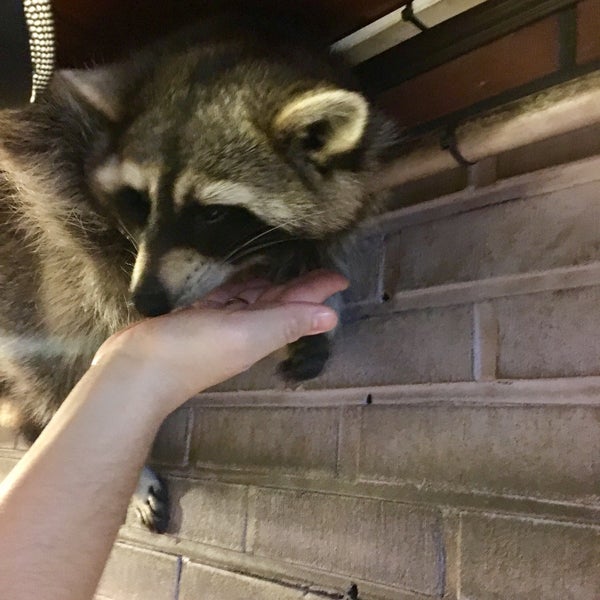 He can eat a dead cat. But raccoons are dangerous for a cat, they can come into conflict with them, and because of their sharp teeth and claws, he will seriously injure the cat. In addition, they are carriers of rabies, ticks, and other parasites and can infect a cat.
He can eat a dead cat. But raccoons are dangerous for a cat, they can come into conflict with them, and because of their sharp teeth and claws, he will seriously injure the cat. In addition, they are carriers of rabies, ticks, and other parasites and can infect a cat.
Do raccoons eat birds
Yes, raccoons do eat birds and bird feathers are often found in their droppings. They have been observed to express sympathy for woodpeckers, songbirds, waterfowl, and bird eggs. They can ruin households and eat domestic chickens and ducklings.
Do raccoons eat rabbits
Yes, there are studies that show that rabbits are included in the raccoon's diet. They usually catch them in private households and in the cold season, when it is difficult to find other food.
Do raccoons eat snakes
Yes, they eat snakes. Fragments of non-venomous snakes are sometimes found in their stomachs.
How to scare a raccoon away from your property
It is almost impossible to scare him away, but you can minimize the damage or stop him from coming to you.
To do this, cut off the lower branches of fruit trees so that he cannot reach them.
A slippery metal fence should be installed on the trunks so that he cannot climb a tree. You can put a grid, they avoid it.
You can use various repellents and spray your trees with them, but in the Russian Federation such repellents are problematic to find.
You can make your own repellant from peppers by simply mixing a bottle of hot sauce with a couple of liters of water.
Onions and several types of peppers can be boiled in water.
These liquids should be sprayed in the garden and raccoons will stay away from such areas, but will need to be done regularly.
Vegetables can be planted around the trees, which raccoons avoid, cucumbers and marrows, they are prickly and animals do not like them.
Various stuffed predators work well for scaring away, lighting loud sounds.
What food is bad for raccoons?
Foods such as garlic and onions are harmful to raccoons and can make them anemic.

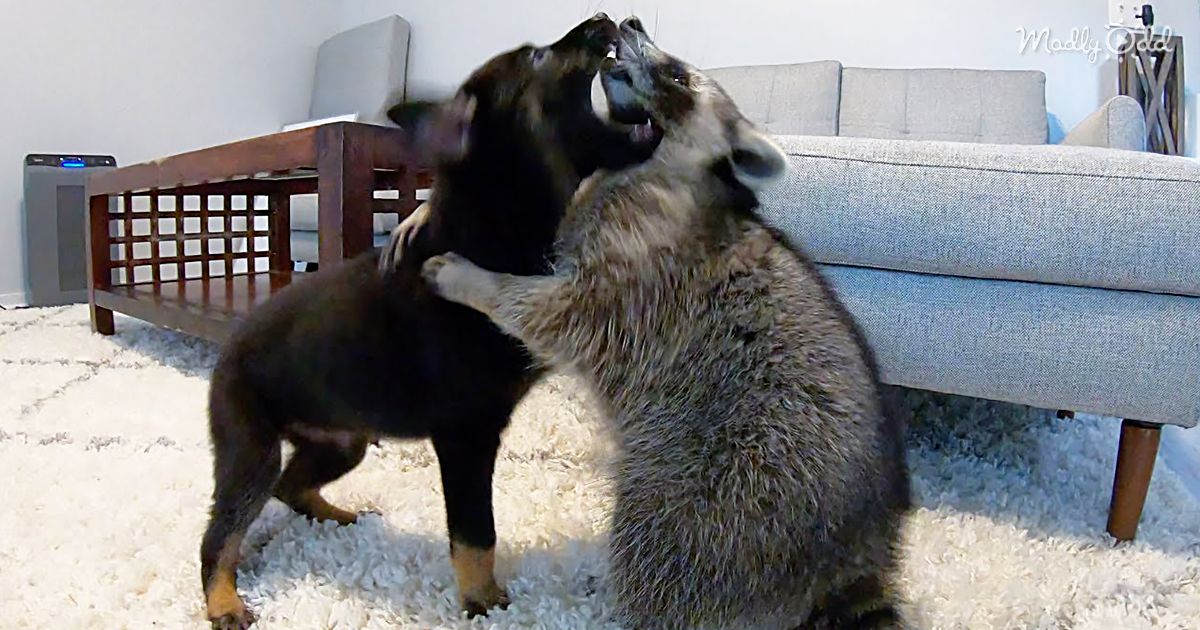
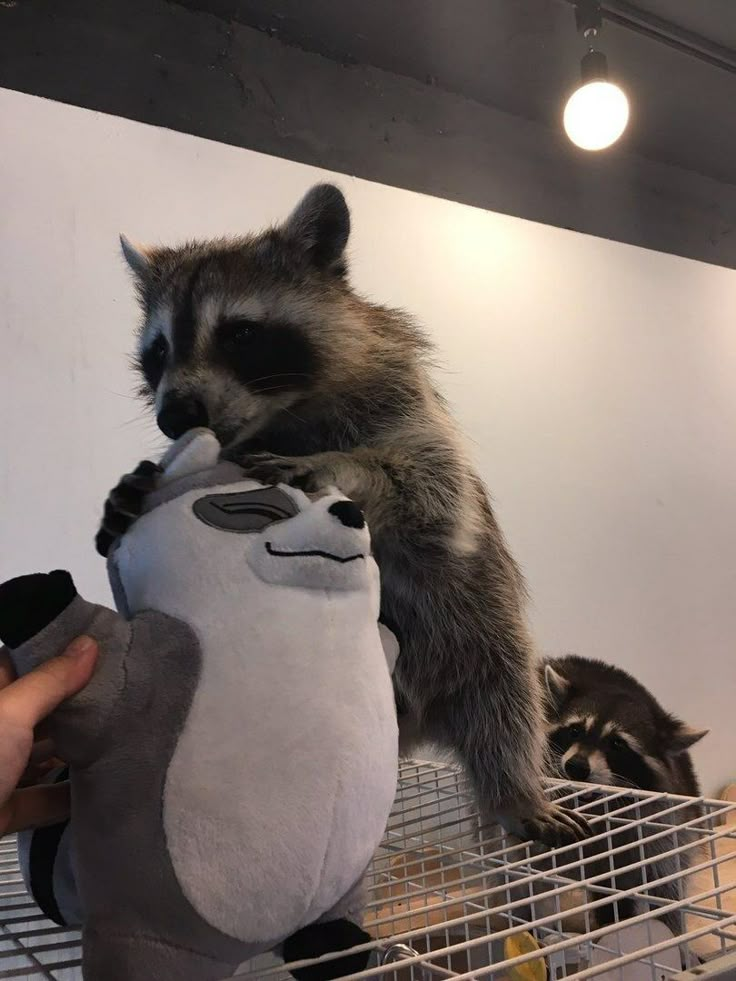 The eyes open at about two to three weeks, the ears shortly thereafter. They now average 7-10" long. They will be VERY vocal at this age. They will churr, growl, hiss, and give an alarm snort. By 4 weeks they are about 12-13" long. When five to six weeks old, most can walk, run, and climb very well. Seven-week-old babies will engage in active (and sometimes rough) fighting characterized by growling, squealing, biting, wrestling, and imitating adult defense postures. They remain in their birth den until they are about seven or eight weeks old, at which point their mother moves them to a series of alternate dens. After about eight to nine weeks of age they begin eating solid foods in the wild and by 10 weeks they travel with their mother. By four months old, they will be completely weaned and somewhat independent. Raccoon mothers with babies enjoy a privileged position in the raccoon hierarchy for as long as the babies remain with the mother. Other raccoons will defer to a female with babies in feeding situations.
The eyes open at about two to three weeks, the ears shortly thereafter. They now average 7-10" long. They will be VERY vocal at this age. They will churr, growl, hiss, and give an alarm snort. By 4 weeks they are about 12-13" long. When five to six weeks old, most can walk, run, and climb very well. Seven-week-old babies will engage in active (and sometimes rough) fighting characterized by growling, squealing, biting, wrestling, and imitating adult defense postures. They remain in their birth den until they are about seven or eight weeks old, at which point their mother moves them to a series of alternate dens. After about eight to nine weeks of age they begin eating solid foods in the wild and by 10 weeks they travel with their mother. By four months old, they will be completely weaned and somewhat independent. Raccoon mothers with babies enjoy a privileged position in the raccoon hierarchy for as long as the babies remain with the mother. Other raccoons will defer to a female with babies in feeding situations. For rehabbers, the appropriate age for releasing hand-raised baby raccoons back into the wild is 16 to 24 weeks. This of course would be subject to the season of the year and the readiness of the animal. I prefer to wait until they are at least 20-24 weeks. At this age they are still young enough that there instincts take over and they become truly wild following their release.
For rehabbers, the appropriate age for releasing hand-raised baby raccoons back into the wild is 16 to 24 weeks. This of course would be subject to the season of the year and the readiness of the animal. I prefer to wait until they are at least 20-24 weeks. At this age they are still young enough that there instincts take over and they become truly wild following their release. 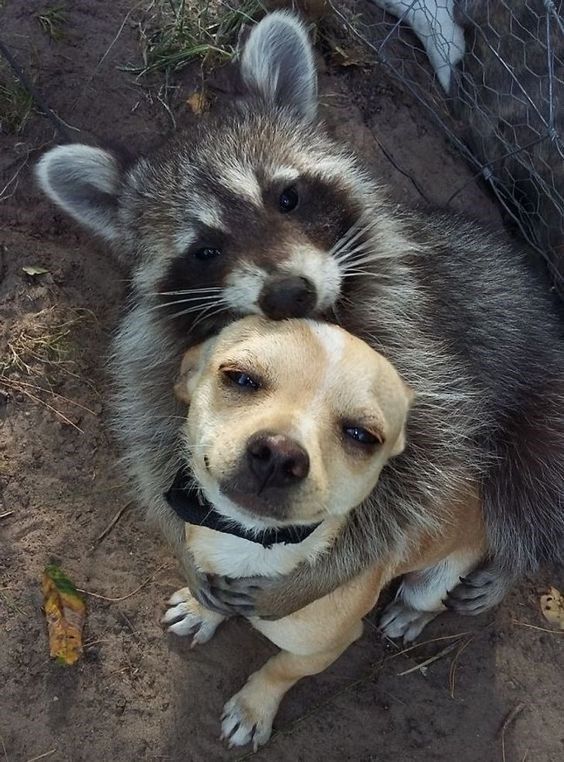 Keep the raccoon in a warm, dark place until the baby has stabilized, WARM SLOWLY over several hours. Warming to fast WILL cause organ failure and they will die.
Keep the raccoon in a warm, dark place until the baby has stabilized, WARM SLOWLY over several hours. Warming to fast WILL cause organ failure and they will die.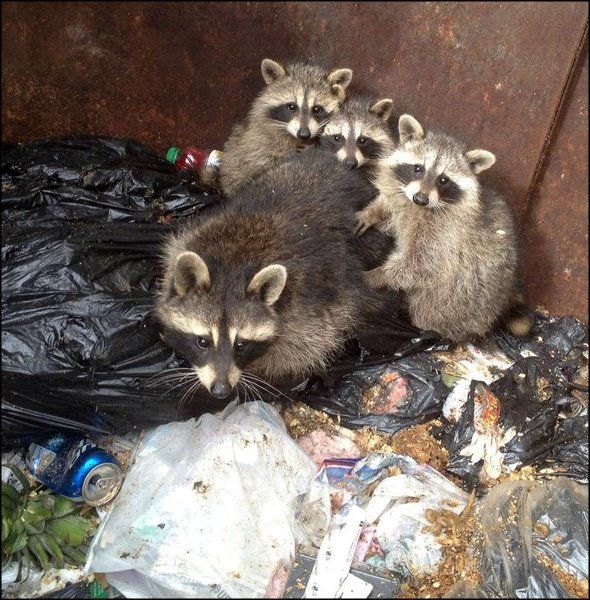

 Don't overfeed! Raccoons will overeat when nursing. Overeating can cause bloat and/or colic resulting in death. Stop nursing the baby when it stops sucking vigorously, stops searching for the nipple or if its little belly feels full. It is better to feed more often than to overfeed. Baby raccoons can drink 1-5% of their body weight in cc’s at a feeding – better you stop before the animal is overfilled and refusing. Gently rubbing or scratching the back of the neck or lower back, where the body meets the tail, may stimulate it to nurse. After feeding is finished, wash its face well with a damp face cloth as the formula dries quickly and will cause fur loss.
Don't overfeed! Raccoons will overeat when nursing. Overeating can cause bloat and/or colic resulting in death. Stop nursing the baby when it stops sucking vigorously, stops searching for the nipple or if its little belly feels full. It is better to feed more often than to overfeed. Baby raccoons can drink 1-5% of their body weight in cc’s at a feeding – better you stop before the animal is overfilled and refusing. Gently rubbing or scratching the back of the neck or lower back, where the body meets the tail, may stimulate it to nurse. After feeding is finished, wash its face well with a damp face cloth as the formula dries quickly and will cause fur loss. If diarrhea occurs, dilute the strength of the formula.
If diarrhea occurs, dilute the strength of the formula.  Most will devour watermelons or uncooked corn on the cob, but do not do this if you want to release the baby in an area where corn or watermelons are grown. Dog biscuits and grapes can be useful bribes. (You may need to cut the grapes in half until the raccoons discover what they are.) Raccoons have a sweet-tooth and may love marshmallows, but use sweets sparingly. It will enjoy fishing and hunting for minnows and crickets, obtained from bait shops. This teaches valuable hunting skills. Raccoons also enjoy digging for grubs, nuts and berries. A raccoon will put anything it finds into its mouth and eats it if it tastes good. Introduce as many natural food items as possible. Raccoons have adaptable opportunistic dietary habits. You can obtain food from a live bait store like Gander Mountain.
Most will devour watermelons or uncooked corn on the cob, but do not do this if you want to release the baby in an area where corn or watermelons are grown. Dog biscuits and grapes can be useful bribes. (You may need to cut the grapes in half until the raccoons discover what they are.) Raccoons have a sweet-tooth and may love marshmallows, but use sweets sparingly. It will enjoy fishing and hunting for minnows and crickets, obtained from bait shops. This teaches valuable hunting skills. Raccoons also enjoy digging for grubs, nuts and berries. A raccoon will put anything it finds into its mouth and eats it if it tastes good. Introduce as many natural food items as possible. Raccoons have adaptable opportunistic dietary habits. You can obtain food from a live bait store like Gander Mountain.  It will then "wash" its food in that same water. Remove the water bowl. Place a litter box in the enclosure. If you are still weaning the raccoon to solid food process, place a small tin with kitty litter next to the feeding area. If the raccoon starts to eliminate, immediately place it in the litter. This will help speed up the process and keep it from using its food bowl as a toilet. Raccoons will share a litter-box. They do not bury their feces, but may knock over the litter-box for fun. Place a piece of concrete under the litter to weigh it down.
It will then "wash" its food in that same water. Remove the water bowl. Place a litter box in the enclosure. If you are still weaning the raccoon to solid food process, place a small tin with kitty litter next to the feeding area. If the raccoon starts to eliminate, immediately place it in the litter. This will help speed up the process and keep it from using its food bowl as a toilet. Raccoons will share a litter-box. They do not bury their feces, but may knock over the litter-box for fun. Place a piece of concrete under the litter to weigh it down. 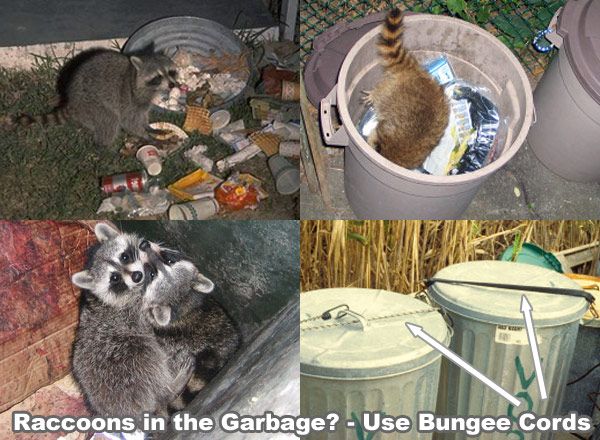 BE DILIGENT ABOUT WORMING. DO NOT MISS A SINGLE DOSE UNTIL RELEASE. Pyrantel pamoate is very low in toxicity because it is not absorbed from the intestine. It is sold under the trade names Nemex, NEMEX-2, and Strongid.
BE DILIGENT ABOUT WORMING. DO NOT MISS A SINGLE DOSE UNTIL RELEASE. Pyrantel pamoate is very low in toxicity because it is not absorbed from the intestine. It is sold under the trade names Nemex, NEMEX-2, and Strongid.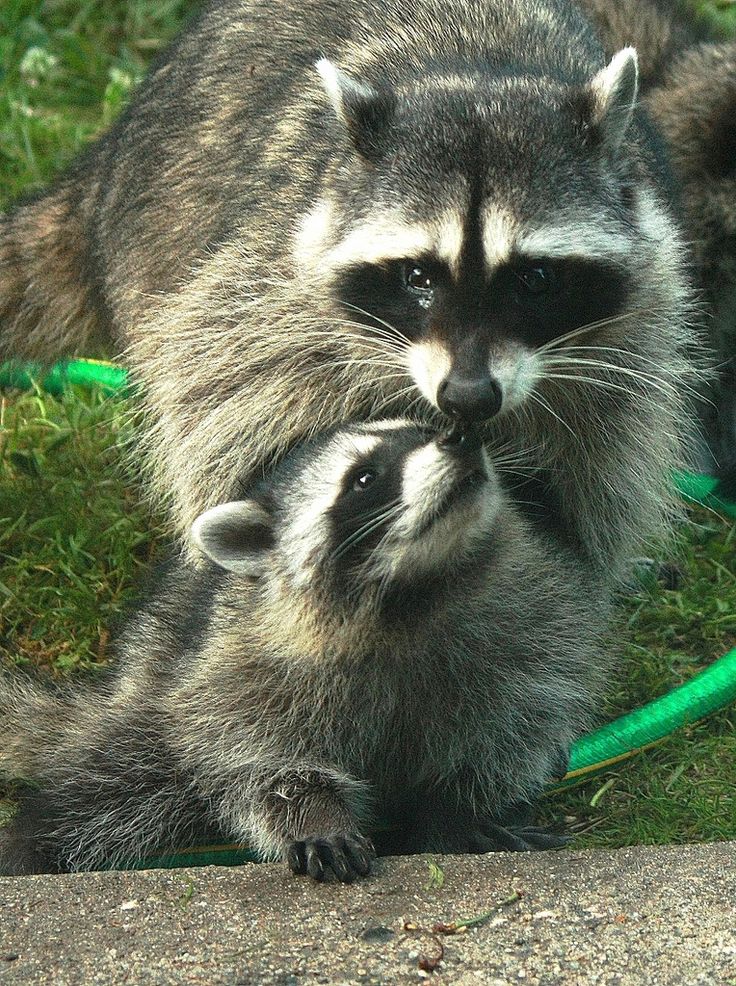 5cc (1/2cc)
5cc (1/2cc) The worm can pass to humans and other animals, causing a very rare disease called visceral larva migrans. The disease is spread through the eggs contained in the feces of an infected raccoon. When the eggs get into another species of animal, they hatch and get confused, as they wander aimlessly about in the body unsure where to go. It may end up in people's brains, eyes and other organs. This condition can cause death or paralysis depending on the location in the body and number of worms. You should use pyrantel pamoate against parasites in raccoons as pyrantel pamoate will kill the parasite in the raccoons' intestines. If you care for orphaned or injured raccoons practice common sense hygiene – the eggs have to get to your mouth, be inhaled from dry raccoon fecal matter or get onto your skin. You can never wash your hands too often, scrub too much or take too many sanitary precautions working with any wildlife – raccoons in particular. Prevention consists of never touching or inhaling raccoon feces.
The worm can pass to humans and other animals, causing a very rare disease called visceral larva migrans. The disease is spread through the eggs contained in the feces of an infected raccoon. When the eggs get into another species of animal, they hatch and get confused, as they wander aimlessly about in the body unsure where to go. It may end up in people's brains, eyes and other organs. This condition can cause death or paralysis depending on the location in the body and number of worms. You should use pyrantel pamoate against parasites in raccoons as pyrantel pamoate will kill the parasite in the raccoons' intestines. If you care for orphaned or injured raccoons practice common sense hygiene – the eggs have to get to your mouth, be inhaled from dry raccoon fecal matter or get onto your skin. You can never wash your hands too often, scrub too much or take too many sanitary precautions working with any wildlife – raccoons in particular. Prevention consists of never touching or inhaling raccoon feces. You should use rubber gloves and a mask when cleaning cages (or attics, etc), which have been occupied by raccoons. Bury or burning all feces, keep children and pets away from raccoon cages and enclosures and disinfect cages and enclosures between litters. Do not keep other animals in cages and nest boxes used for housing raccoons. Raccoons may have fecal matter on their paws and bodies, so take appropriate safeguards. When raccoons are taken into rehab, they should receive de-worming IMMEDIATELY.
You should use rubber gloves and a mask when cleaning cages (or attics, etc), which have been occupied by raccoons. Bury or burning all feces, keep children and pets away from raccoon cages and enclosures and disinfect cages and enclosures between litters. Do not keep other animals in cages and nest boxes used for housing raccoons. Raccoons may have fecal matter on their paws and bodies, so take appropriate safeguards. When raccoons are taken into rehab, they should receive de-worming IMMEDIATELY.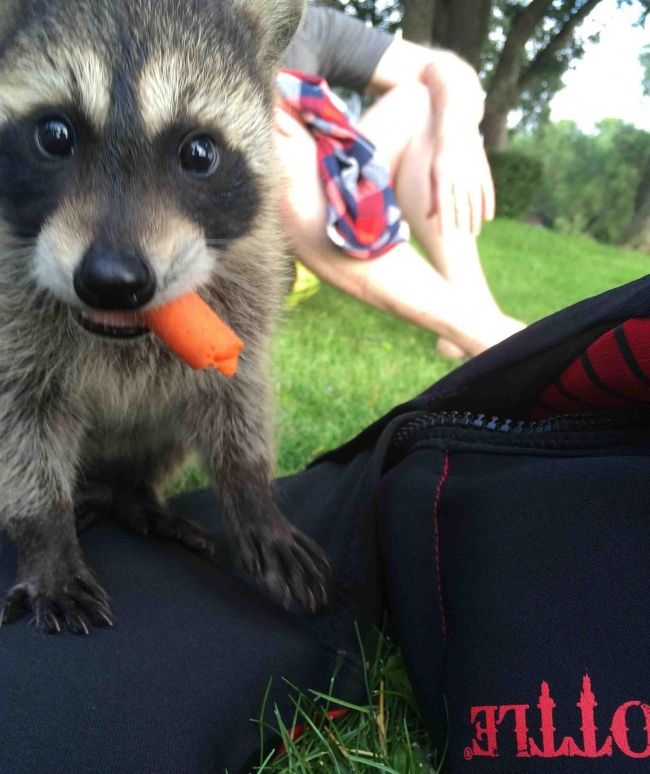 When you grasp a tick to pluck it off with tweezers, grasp the bleb of skin just ahead of the tick and the whole thing will come out. That bit of tissue will die anyway, and grasping a tick by its abdomen simply injects all the toxins and infections the ticks carry into the baby. You can give them an initial scrub/bath with Johnson's Baby Shampoo and then blow-dry them. The accepted dose for 1% ivomectin solution orally is 200mcg/kg (which works out to about 0.1ml/10 lbs, some use half this dose).Others use fenbendazole (Panacur) @ 50mg/kg for three successive days. None of these products are approved for this use and there are no medicines, other than oral rabies vaccine, that have been tested or approved for use on raccoons.
When you grasp a tick to pluck it off with tweezers, grasp the bleb of skin just ahead of the tick and the whole thing will come out. That bit of tissue will die anyway, and grasping a tick by its abdomen simply injects all the toxins and infections the ticks carry into the baby. You can give them an initial scrub/bath with Johnson's Baby Shampoo and then blow-dry them. The accepted dose for 1% ivomectin solution orally is 200mcg/kg (which works out to about 0.1ml/10 lbs, some use half this dose).Others use fenbendazole (Panacur) @ 50mg/kg for three successive days. None of these products are approved for this use and there are no medicines, other than oral rabies vaccine, that have been tested or approved for use on raccoons.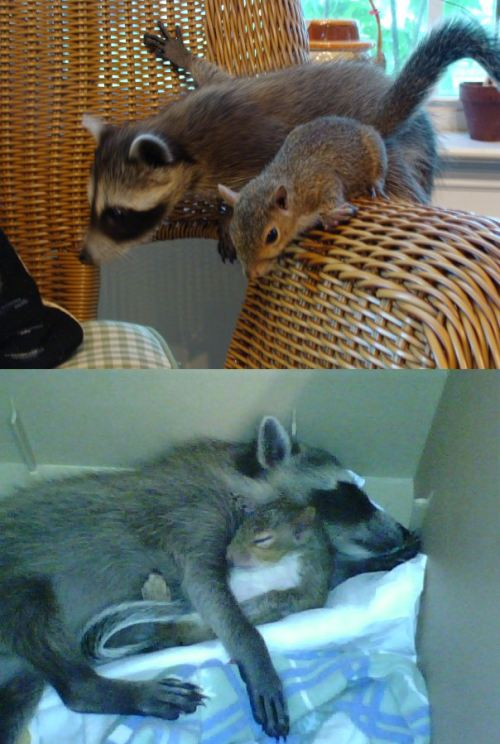 If you are concerned about rabies, you may want to consider having a pre-exposure vaccine for anyone who will be handling the animals-call your vet for further information. Furthermore, with all animals, you should always take precautions to avoid being bitten while you are handling the animal.
If you are concerned about rabies, you may want to consider having a pre-exposure vaccine for anyone who will be handling the animals-call your vet for further information. Furthermore, with all animals, you should always take precautions to avoid being bitten while you are handling the animal. 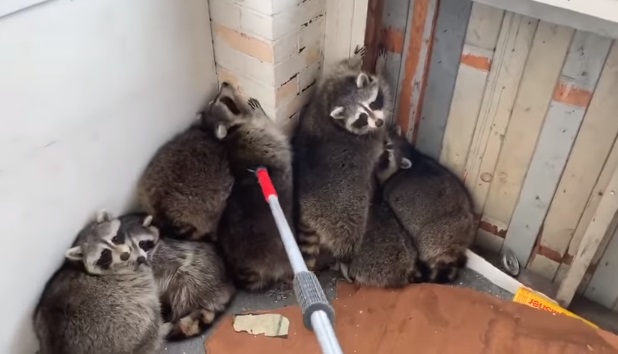 Best for use against distemper, GALAXY-D (Canine) DISTEMPER Vaccine.
Best for use against distemper, GALAXY-D (Canine) DISTEMPER Vaccine.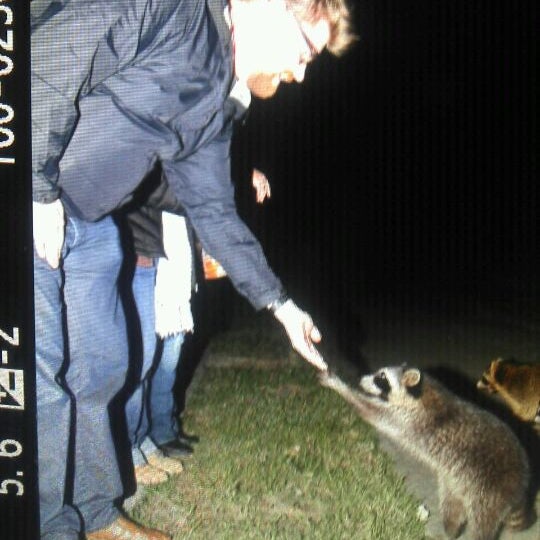
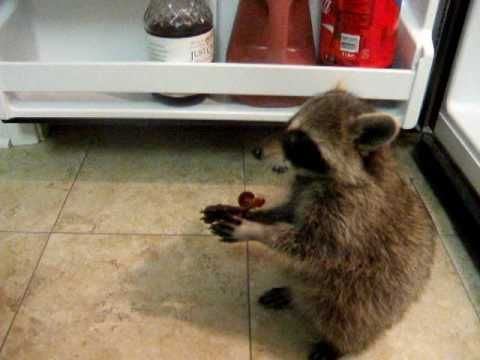 You can use a smaller enclosure with just branches, toys, their food bowl, litter box and bed (animal carrier), if you can take them into the woods each day when they are about 10 weeks old.
You can use a smaller enclosure with just branches, toys, their food bowl, litter box and bed (animal carrier), if you can take them into the woods each day when they are about 10 weeks old. 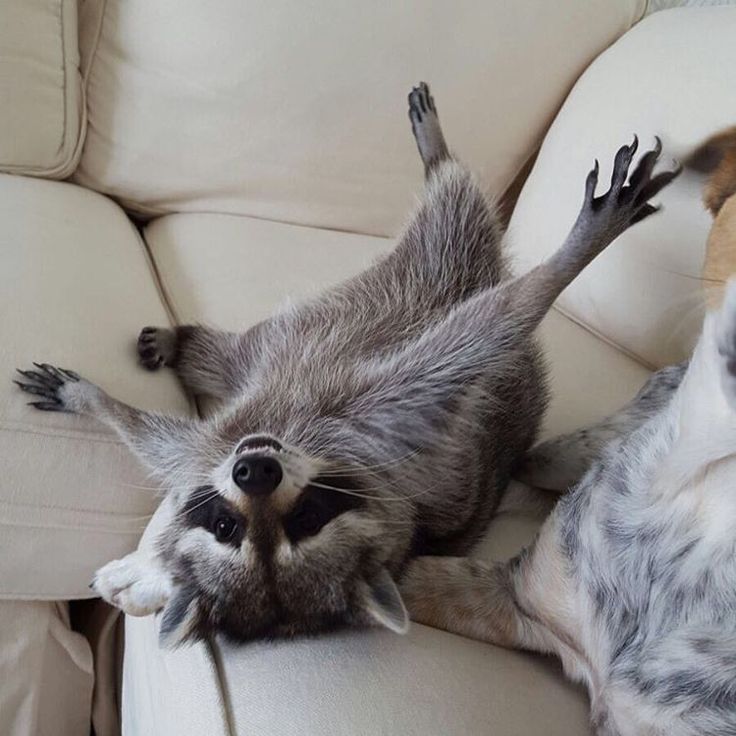 If the raccoon is handled from an early age, it will help make it more sociable and less prone to bite. After they are weaned, you should start distancing yourself from them, to break the human bond. You should also start limiting their human contact to just yourself. As they get older they will get quite playful, which increases the chances of your being bit, especially if the raccoon feels threatened. Part of growing and maturing is rough-housing, biting, scratching and playing with other raccoons. Growing raccoon kits can bite, nip, scratch and destroy anything in sight. Use precaution and heavy gloves and make it clear that they must not be rough with you. Sharply say "NO" and growl or hiss at them. If they are by you at the time, gently shake the scuff of their neck while you do this. The scuff of the neck works well with raccoons - their mothers carry them by it, shake them by it and will pin them down by it when they really tick mom off.
If the raccoon is handled from an early age, it will help make it more sociable and less prone to bite. After they are weaned, you should start distancing yourself from them, to break the human bond. You should also start limiting their human contact to just yourself. As they get older they will get quite playful, which increases the chances of your being bit, especially if the raccoon feels threatened. Part of growing and maturing is rough-housing, biting, scratching and playing with other raccoons. Growing raccoon kits can bite, nip, scratch and destroy anything in sight. Use precaution and heavy gloves and make it clear that they must not be rough with you. Sharply say "NO" and growl or hiss at them. If they are by you at the time, gently shake the scuff of their neck while you do this. The scuff of the neck works well with raccoons - their mothers carry them by it, shake them by it and will pin them down by it when they really tick mom off. You grab just skin and fur. They can't turn their head around enough to bite you and if you pick them up that way they usually just hang there quite docile (must be instinctive.) Do not try this with wild or adult raccoons.
You grab just skin and fur. They can't turn their head around enough to bite you and if you pick them up that way they usually just hang there quite docile (must be instinctive.) Do not try this with wild or adult raccoons. 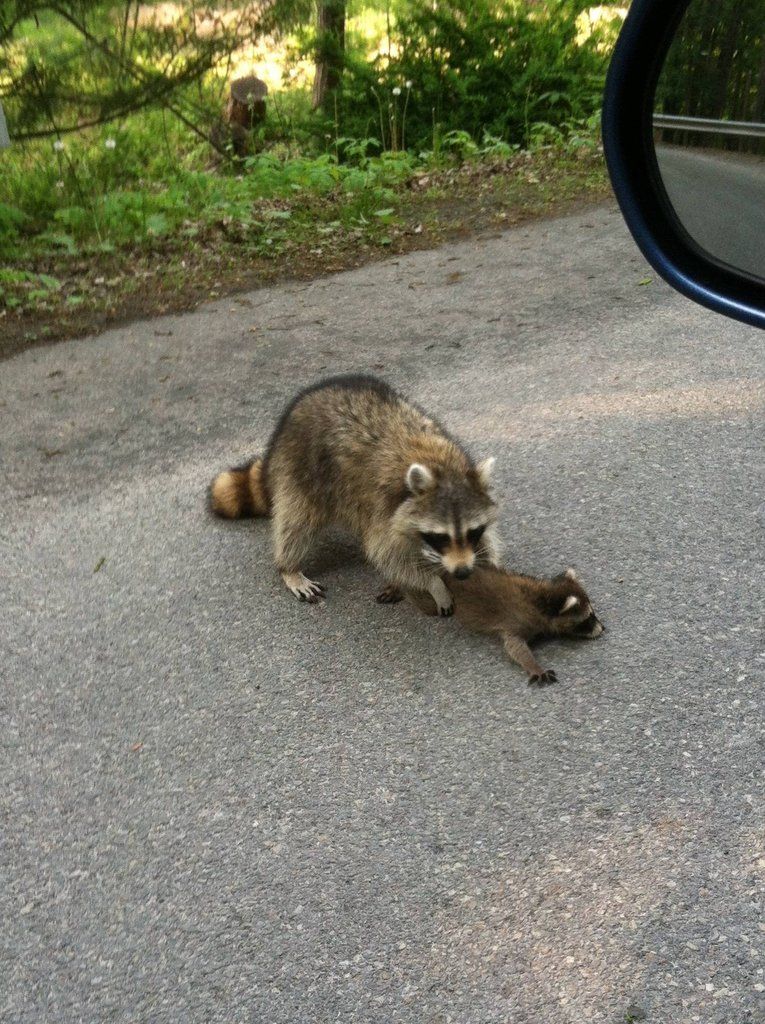 At this age, they should follow you, but as they get older the bravest of a litter can lead the others quickly astray. The raccoons will enjoy playing in a wheel barrel filled with water. If you place minnows in the barrel, this will help the raccoons learn to fish. The raccoons will also rummage for food in leaves on the ground. You can lead the raccoons to smaller isolated trees, where they can be more easily retrieved or coaxed down with a bribe. The first couple of times, they may be a little leery and you might have to help them up and down. After that, they discover all the good things about trees (food, shelter, fun) and you'll find them making a run for the trees.
At this age, they should follow you, but as they get older the bravest of a litter can lead the others quickly astray. The raccoons will enjoy playing in a wheel barrel filled with water. If you place minnows in the barrel, this will help the raccoons learn to fish. The raccoons will also rummage for food in leaves on the ground. You can lead the raccoons to smaller isolated trees, where they can be more easily retrieved or coaxed down with a bribe. The first couple of times, they may be a little leery and you might have to help them up and down. After that, they discover all the good things about trees (food, shelter, fun) and you'll find them making a run for the trees.  They may become almost nocturnal. Then you can release them into non-hunting areas in the areas where they were born. You may leave food and check back, but they will not need any more help if they have successfully returned to the wild.
They may become almost nocturnal. Then you can release them into non-hunting areas in the areas where they were born. You may leave food and check back, but they will not need any more help if they have successfully returned to the wild.  Provide toys - natural ones are best - acorns, cones, small twigs, bark, limestone chunks, shells, rocks/pebbles, flower seeds, etc., but hard dog toys, cat toys, children's toys are fine too.
Provide toys - natural ones are best - acorns, cones, small twigs, bark, limestone chunks, shells, rocks/pebbles, flower seeds, etc., but hard dog toys, cat toys, children's toys are fine too. 